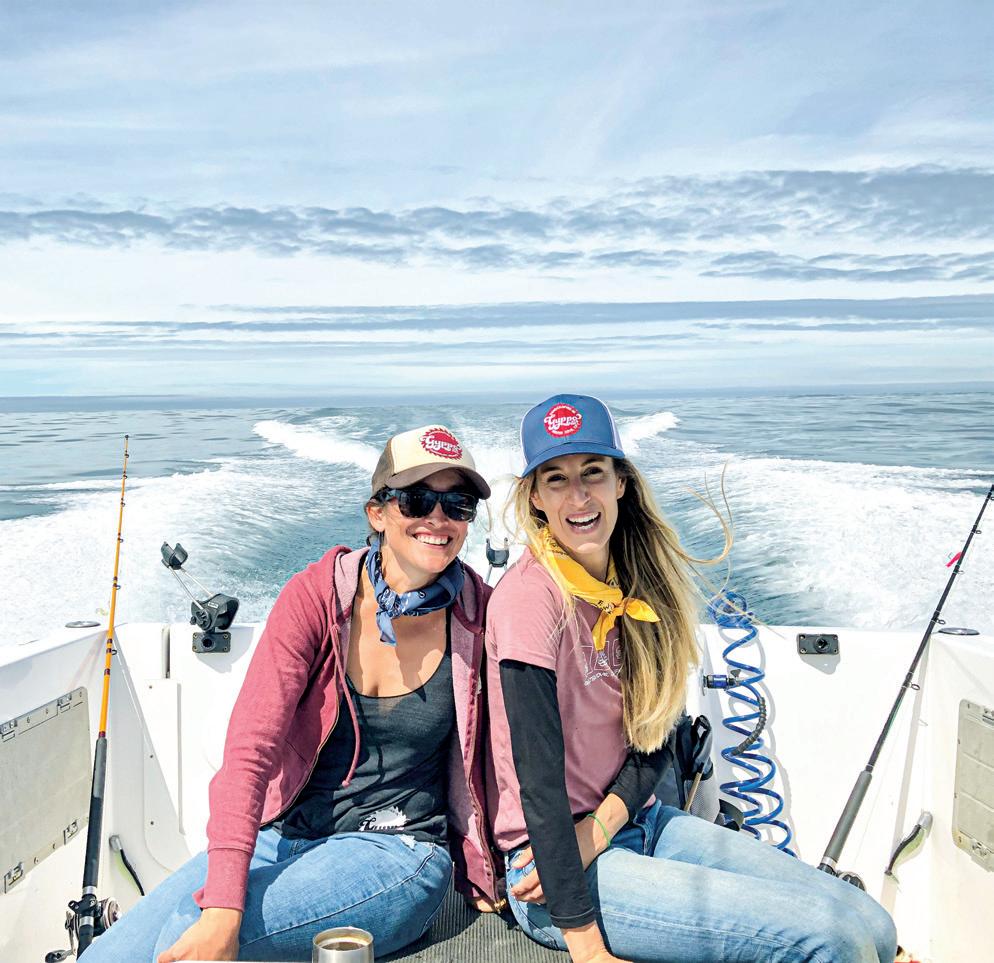










PUBLISHER
James R. Baker
GENERAL MANAGER
John Rusnak
EXECUTIVE EDITOR
Andy Walgamott
EDITOR
Chris Cocoles
CONTRIBUTORS
Mark Fong, Scott Haugen, Tiffany Haugen, Tiffany Herrington, Tim E. Hovey, Cal Kellogg
SALES MANAGER
Paul Yarnold
ACCOUNT EXECUTIVES
Janene Mukai, Tom St. Clair
DESIGNERS
Gabrielle Pangilinan, Lesley-Anne Slisko-Cooper
PRODUCTION ASSISTANT
Emily Baker
DIGITAL STRATEGIST
Jon Hines
ADMINISTRATIVE ASSISTANT
Katie Aumann
INFORMATION SERVICES MANAGER
Lois Sanborn

ADVERTISING INQUIRIES ads@calsportsmanmag.com
CORRESPONDENCE
Email ccocoles@media-inc.com
X @CalSportsMan Facebook.com/californiasportsmanmagazine
ON THE COVER
Scott Haugen rates mature blacktail deer as the toughest of big game targets in North America. This month, Haugen discusses how to hunt pressured blacktails during the peak of October’s deer seasons. (SCOTT HAUGEN)
MEDIA INC PUBLISHING GROUP 941 Powell Ave SW, Suite 120 Renton, WA 98057 (800) 332-1736 • Fax (206) 382-9437 media@media-inc.com www.mediaindexpublishing.com Volume 16 • Issue 12






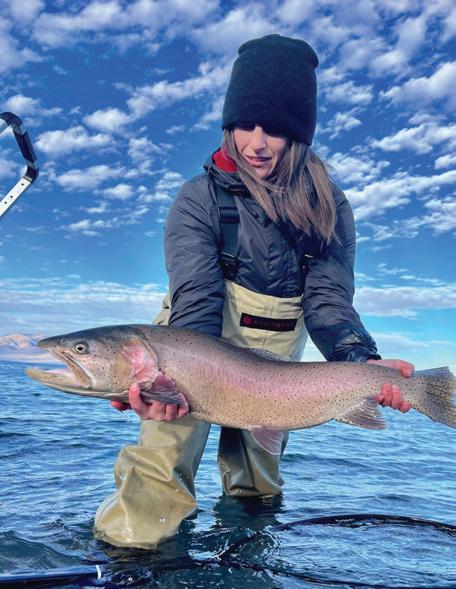
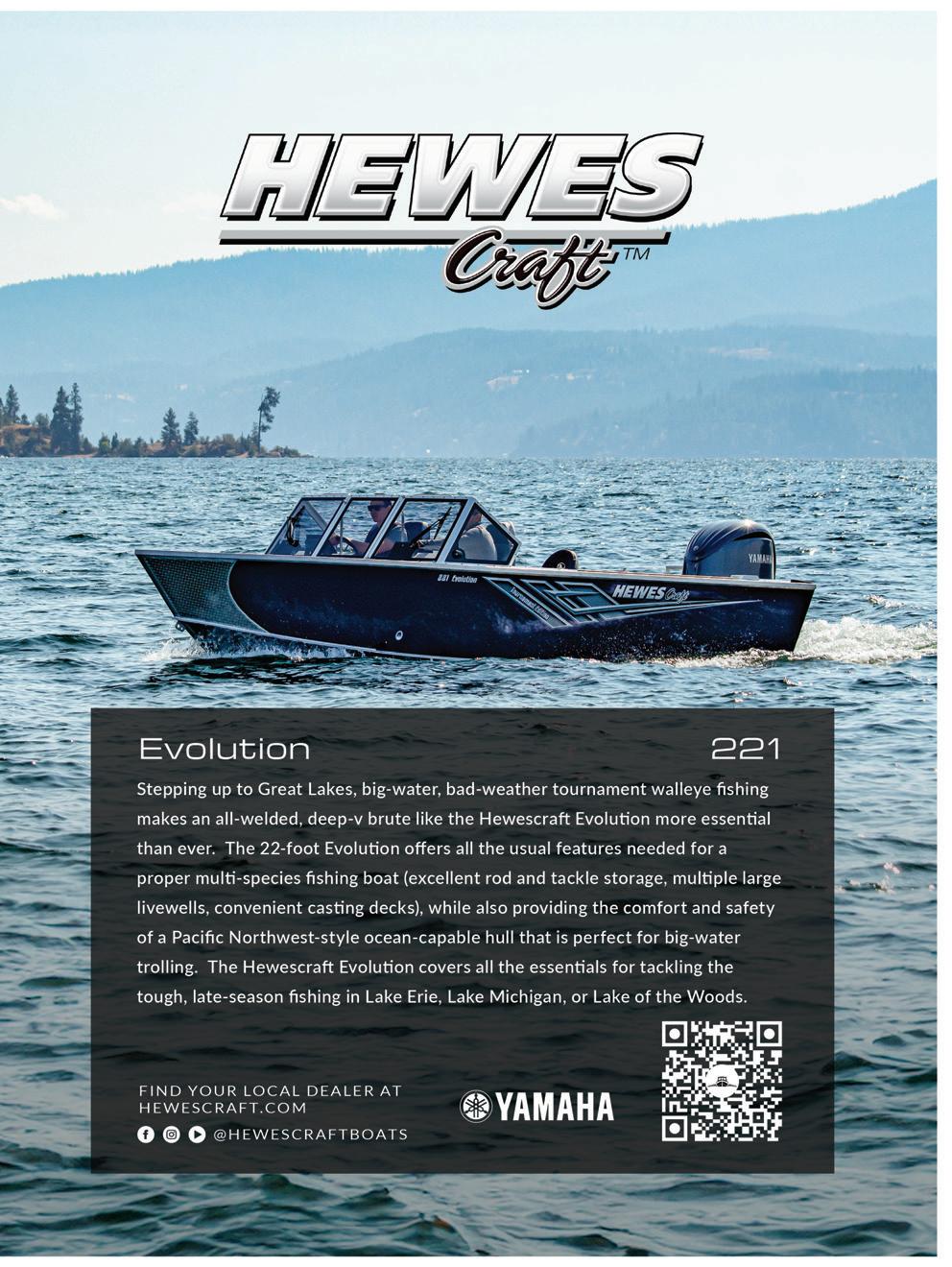
23 BLACKTAIL PRESSURE POINTS
As hunters head into the wilderness in hopes of filling their deer tags this month, the prized blacktails they’re seeking become even more wary. “An old buck knows what’s happening and instantly becomes reclusive with increased pressure,” Scott Haugen advises in our monthly From Field to Fire column. Find out how Scott successfully hunts these on-edge bucks this time of year, and then look ahead to Dungeness season with chef Tiffany Haugen’s crab fries recipe!
31 NOT YOUR GRANDPA’S AIR RIFLE
9 The Editor’s Note
11 Outdoor Calendar
13 How to pursue bucks in fire-scarred habitat
37 Hunt native gray squirrels with versatile gun dogs
53 Feather River’s underrated steelhead fishery
Tim Hovey learned to handle firearms and hunt with a simple BB gun, and he continues to enjoy hunting small game with airguns these days. Except today’s air rifles are more technologically advanced, come in larger calibers and shoot upland birds and rabbits with precision. Hovey breaks down some of his favorite new toys that he hunts with.
SOMETHING
On Nor thern California’s spectacular Lost Coast, a husband and wife’s love for beer and the outdoors led to the creation of Gyppo Ale Mill, a microbrewery that serves up locally inspired pints and seafood delicacies sourced from the area’s fishing community. Tiffany Herrington shares the story of this successful business venture.
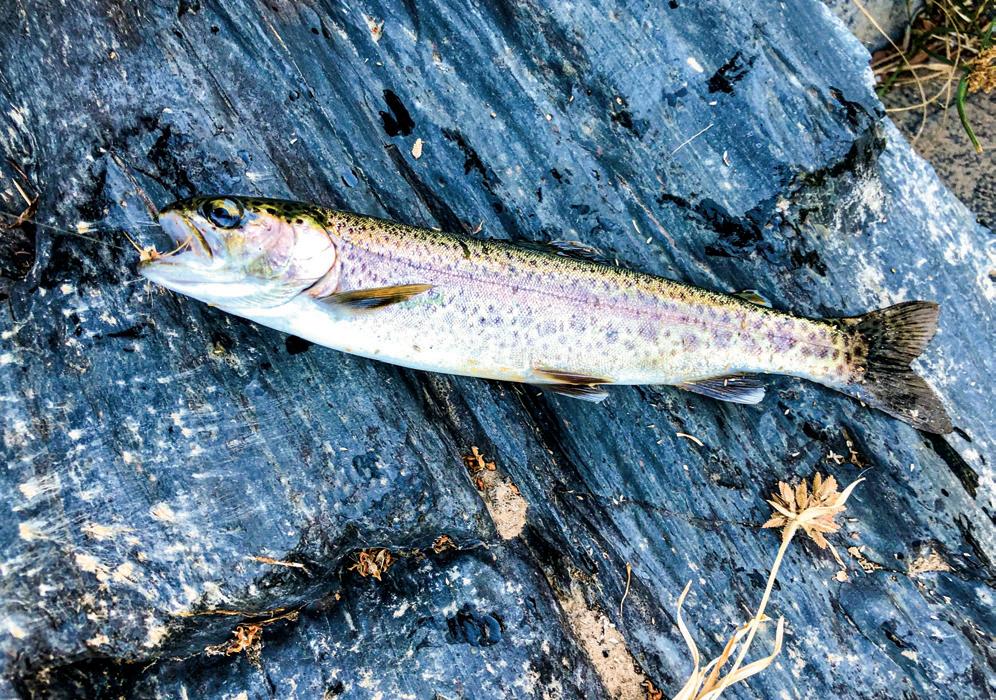
Two of Cal Kellogg’s most passionate activities often go hand in hand, as the longtime sportsman totes his fly rod, lucky 10-inch pan and crevice tool into the backcountry. Why? Because he gets the best of both worlds: catching feisty wild trout and – if he’s even more lucky – scooping up some nuggets in those same Gold Country and Motherlode streams. Stake your claim with Kellogg!



Iused to bug my dad so much about taking me fishing that he must’ve subconsciously rolled his eyes the time I asked him if we could pan for gold.
My dad, sisters and I spent a lot of time in California’s Gold Country – specifically, around the Sonora area. Every winter Dad’s car club had a “Snow Tour” overnight trip that included a drive to nearby Strawberry for inner tubing on bunny slopes (capped off by an awesome fondue restaurant in Jamestown). Plus, his best friend owned a weekend getaway in Columbia, which plays up to its California Gold Rushinspired nickname, “Gem of the Southern Mines.”
Columbia has a quaint but touristy historic center that preserves its mining town heyday. Among the gimmicks it offered way back when was a chance to pan for gold. Sure enough, I pestered my dad to let me strike a claim of my own – too young and naive to know it was likely folly. I was shot down and I’m certain I pouted as we walked around the rest of the historic district. Perhaps back then I wanted to channel my inner Yukon Cornelius, my favorite eccentric dreamer of a prospector from Rudolph the Red-Nosed Reindeer
Truth be told, I don’t recall ever asking again about the gold panning thing, but our correspondent Cal Kellogg has me reminiscing. Shortly after Kellogg started contributing to the magazine last year, he told me about his passion for gold panning in the streams in and around the region that spawned California’s Golden State nickname in 1848.
In a Kellogg-penned story this month (page 42), he combines his loves of searching for trout and nuggets in Gold Country streams.
“For me, trout fishing and gold prospecting go hand in hand. Back in the 1970s when I was very young, my parents would vacation in the Yuba River country. My mom would pan for gold and my dad would fish for trout,” Cal tells me.
“I caught my first trout on one of those trips and saw the flash of California gold in my mom’s pan. These events ignited a lifelong passion for both trout fishing and prospecting. Both sports are highly addictive. You can never catch a big enough trout and you can never find enough gold!”
I doubt I would have struck it rich that day in Columbia, but my dad did take me trout fishing enough times to make up for shooting me down. Here’s hoping Cal keeps finding the treasures in them thar hills. -Chris Cocoles

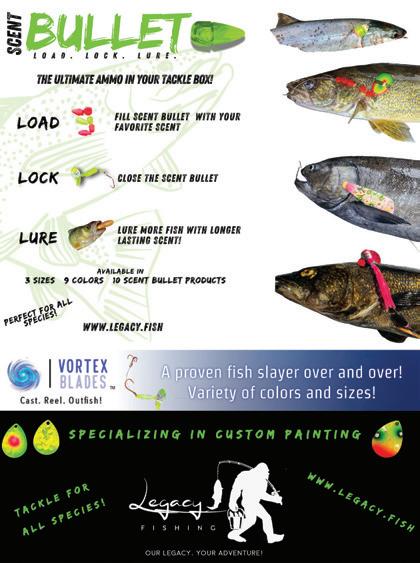


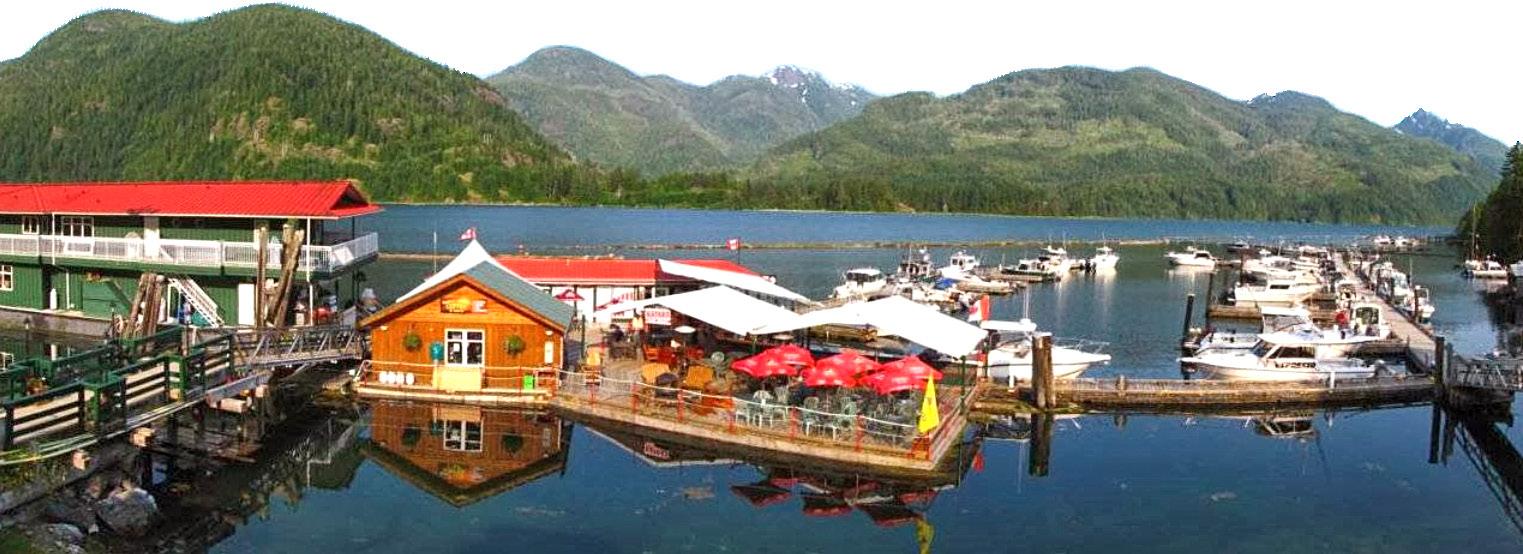





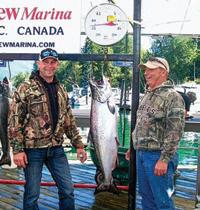

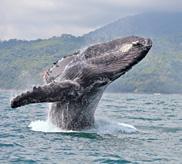

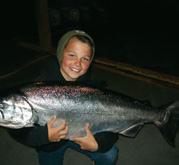







5 Most X Zone general deer seasons open
5 Zone D-12 archery deer season opens
5 Nor theast Zone waterfowl season opens
5 Klamath Basin geese season opens
5 Nor th Coast Canada geese season opens
5 Central Coast antlerless tule elk season opens
5 San Luis Reservoir either-sex tule elk season opens
5-6 Mojave National Preserve early quail season dates for hunters with junior hunting licenses
5-6 FPT Western Tour Classic bass tournament, Sacramento River; anglerspress.com/sign-up/fpt-top-75-classic-championship/group-registration
12 Zones D-11, D-13, D-14, D-15 and D-17 general deer seasons open
12 Cache Creek period 1 bull tule elk season opens 12 La Panza antlerless elk season opens 12 Bear Valley antlerless and bull tule elk seasons open 12 Archery-only pheasant season opens 19 Statewide chukar season opens 19 Statewide snipe season opens 19 Zone X-9C general deer season opens
19 Zones Q1 and Q3 all-quail seasons open
25-27 Morrison’s Bonus Derby Weekend, Convict Lake; (800) 992-2260, convictlake.com/activities/fishing-convict-lake
26 Mark Stasyuk Memorial Fishing Tournament, Tower Park, Rancho Cordova; anglerspress.com/events/ mark-stasyuk-memorial-tournament
26 Zone D-16 general deer season opens
26 Southern San Joaquin Valley and Southern California Zones duck and geese seasons open
26 Balance of State Zone duck and geese seasons open
2 Zone D-12 general deer season opens
2 NorCal Guides and Sportsmen’s Association fundraising dinner; FIVE30 Event Center, Marysville; ncgasa.org
2-3 NorCal Trout Challenge Tournament of Champions, Collins Lake; anglerspress.com
2-10 Fort Hunter Liggett only antlerless elk season dates 4 Imperial County Zone white geese season opens 7 Scaup hunting opens in most state zones 9 Fall wild turkey season opens 9 General/statewide pheasant season opens 9 Late dove season opens 9 Gabilan antlerless and bull elk hunting seasons open 18 Nor thern black brant season opens 19 Balance of State black brant season opens
For a list of upcoming bass tournaments, go to nrm.dfg.ca.gov/ FishingContests/default.aspx.
General black bear season is open concurrently with the general deer hunting season in deer zones A, B, C, D, X8, X9A, X9B, X10 and X12 and extends through December 29. In the portions of Zones X-1, X-2, X-3a, X-4, X-6a, X-6b, X-7a and X-7b open to bear hunting, the general bear season begins October 12 and extends through December 29.





By Cal Kellogg
Picture the scene: A fire swept through the area over a year ago. Hillsides and gullies that were once choked with visionblocking vegetation are now wide open. The brush is completely gone, and while many trees are still standing, they are black – dead reminders of the forest that once was.
It rained a bit overnight, so you can move over the scorched ground in relative silence. You’ve been on the move for about an hour working along the top of a ridge when you see movement in your peripheral vision some 50 yards away.
You don’t need binoculars to identify one of the three deer as a shooter. He is a mature old battler with high, chocolate-colored antlers
with multiple points. When he moves forward and his big, blocky body clears the black trunk of what used to be a large oak, you center the crosshairs behind his shoulder and seal the deal. You’ll be eating venison all winter and earn hero status to all your hunting buddies when they get a look at the four-point’s heavy rack!
Yep, this is indeed the stuff dreams are made of. And like the idea of

This buck was photographed on the fringe of 2022’s Mosquito Fire in Placer County. “Overall, burns are good for regional deer numbers,” author Cal Kellogg says. “Yet to score a burn-habitat buck you’ll have to use your head, work hard, be persistent and hopefully enjoy a side order of good old-fashioned luck.” (CAL KELLOGG)
winning the lotto or dating the Hawaiian Tropic bikini team, it’s not going to happen …
“What? Wait a second,” you think. “I’ve been hearing all my life that burns are nirvana for West Coast blacktail hunters. All I need to do is waltz out into an old burn and collect my buck of a lifetime, which has grown fat and sassy while gobbling down fresh, high-quality browse.”
I wish it were that easy, but it’s my job to level with you. It’s true that some burns do indeed attract deer, and overall burns are good for regional deer numbers; yet to score a burn-habitat buck you’ll have to use your head, work hard, be persistent and hopefully enjoy a side order of good old-fashioned luck!
I’ll begin with a rant: Road hunting is not hunting. Driving around a burn in your Powerstroke diesel is a poor deer hunting strategy. Period. End of story. Not only does road hunting offer you a minimal chance of success, it also drives the deer into deeper cover, which makes it harder for others. And it makes the whole hunting community look bad,
because it dovetails with the antihunting image of fat, lazy hunters driving around shooting signs and anything that moves. ’Nuff said. When it comes to actually hunting burns, the conditions play a huge role in the preferred method at any given time. If the ground is dry, hiking and still hunting is not a great approach because it’s difficult to move quietly.
This skews the odds in the favor of the deer with their keen sense of hearing. When it’s clear and dry, the deer are going to be most active early and late when the light level is low. This is a good time to find a vantage point along the edge of a burn, settle in for a long sit and glass. You can be successful spotting a deer at long range and stalking to within shooting distance, but the noise you create covering dry ground is going to be a serious liability.
In the morning, wind typically won’t be a huge factor to consider in terms of where you set up. As the temperature rises, the air current will drift uphill. The evening is another story. When the sun drops behind the ridges, your scent will roll downhill, so it’s important not to sit directly above the area you expect to see deer.
When it’s raining or has rained and overcast skies remain, the odds shift in favor of the hunter. Damp, low-light conditions encourage deer to feed, and they will often be active all day long.
A little rain can turn ground that was once dry and noisy into a spongy carpet, which allows a slowly moving hunter to cover ground in relative silence. This is the time to move slowly into a headwind or quartering
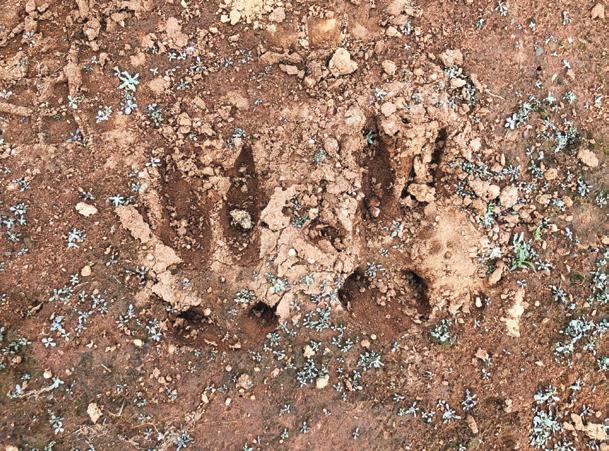

While I’ve spent my share of time prospecting for bucks in burns, I consider my college buddy Justin Price a real expert. Justin grew up hunting for blacktails in California. In the early 2000s his career took him to Oregon, where he spent countless hours scouting and hunting burn areas.
Price broke down the factors and variables that affect deer habitat after wildfire damage.
“There have always been fires in California, Oregon and Washington, but 20 years ago or so, things changed. We used to have fewer fires and conditions were such that it was the rare fire event that truly got out of control. Clearly conditions have changed. Summer conditions are hotter and most years the hot, dry season extends into the early fall. This makes for tinder-dry fuels. Add to this the fact that there are more people living in rural areas than ever before and the stage is set for more fires to get started; those fires have the potential to grow more quickly than
was possible in the past.”
“Forest management is also a factor in the big burns we’ve seen. There has been a long-time shift toward managing mature timber. As a result, there is less logging, fewer controlled burns and more fuel accumulation on the forest floor. Once the floor fuels start to burn, the fire easily ladders up into the canopy. When this situation is combined with wind, the sort of firestorms we’ve seen all along the West Coast in recent years become inevitable.”
“Take the human loss off the table in the form of burned structures and the loss of life, and fires can be a net positive. They clean up fuels that have been accumulating for half a century, and the opening of the canopy allows more tender vegetation to grow on the forest floor. Yet when super-dry fuels are plentiful and the wind is blowing, fires often burn so hot that large swaths of the soil are basically sterilized.”
“Contrast a firestorm event to your average fire event or a controlled burn
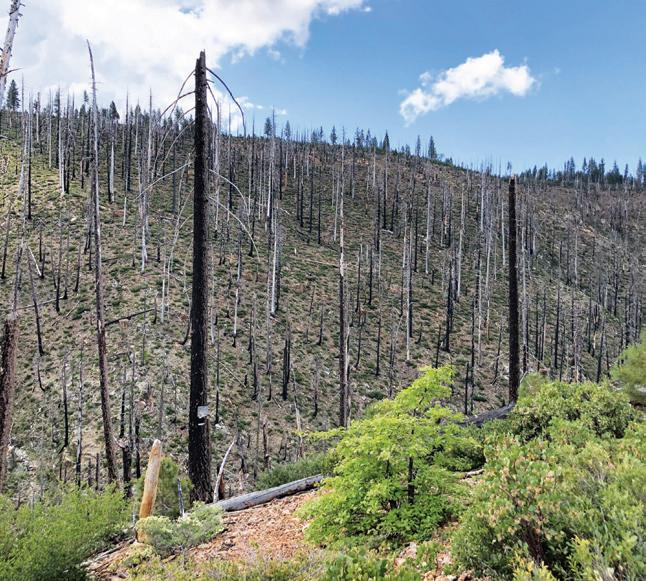
that moves along at a slower pace and burns at a lower temperature. These fires remove fuel and rejuvenate the ecosystem. These are the types of areas where I have the most success hunting.”
“If you are seeing areas that were totally nuked by a hot fire with the ground and what remains of the trees baked black with no sign of new growth, these areas will not offer productive hunting for many years.”
I asked Price to describe what he feels is the optimum type of burn to hunt.
“Just like any other type of hunting situation, the more time you put in scouting and planning the better you’ll do when hunting burns. Burns absolutely produce bigger deer numbers over time and bigger bucks in general, but you’ve got to identify key areas,” Price says.
“I’ve had my best success working the fringes of burns. Even if deer are feeding in a burn, you likely won’t find them way out in the open during shooting hours. They like to work the fringes because they can move into the open and feed during the night and retreat into cover during daylight hours.”
“I seek out areas where fingers of fire worked into forested areas that didn’t burn. In these areas, the flames were almost always cool enough not to destroy the soil, so you are going to see the regrowth the deer seek out. I avoid hunting flat, easily accessed areas. I like the area I focus on to have plenty of coves, hollows and small canyons. Deer feel much more comfortable bedding and operating in this sort of terrain. Finally, if it has new growth, broken terrain and water in the form of a stream or spring, it moves to the top of my list.”
“Think about it; what do the deer want? They need high-quality feed, shelter and water. Find all three in a small area and you’ve got a good place to focus your efforts. The next step is getting boots on the ground, finding tracks and figuring out what the deer are doing. Where are they feeding and where are they bedding are key questions. I’m old school in that I gather much of my intelligence from just walking the ground and observing. I know guys who hunt the areas I do that hang trail cameras and learn a lot about when the deer move and what sort of bucks are using a given area.” -CK


wind, ghosting around hollows and gullies following the edge of the burn.
Don’t expect to see deer standing out in the open; instead, use your binoculars to scan the edge of the unburned vegetation. Don’t look for whole deer. Pick the cover apart looking for body parts or the telltale
flick of an ear or tail. If you think you are moving slow enough, slow down a little more and don’t get complacent. When still hunting in close cover, you’ve got to be ready for a shot to develop at any moment. You don’t want to be caught flat-footed. Effective still hunting is a mental chess game.
Your goal is to sneak up on a deer. The goal of the deer is not to allow a predator to sneak up on them. When the conditions are right, still hunting is a thrilling, high-stakes approach!
Stand hunting has long been my preferred method of filling deer tags. When the deer are moving and you are stationary, you have a tremendous advantage since you aren’t making noise, spreading your scent or being betrayed by movement.
Another upside of stand hunting is that quality shot opportunities at standing or slowly walking deer typically develop. Contrast this with still hunting, when shots at trotting or running deer are the norm.
For a long time, I hunted from both permanent and portable treestands, but I lost my nerve for climbing. My dad is an old-time construction worker, and he advised me, “If you are afraid of falling, you’ll fall.”
These days I hunt from strategically located ground blinds. When setting a ground blind, you don’t enjoy the visibility offered by a treestand and I also feel the deer have less chance of scenting you when you are up in a tree. If you are comfortable in a treestand, by all means climb!
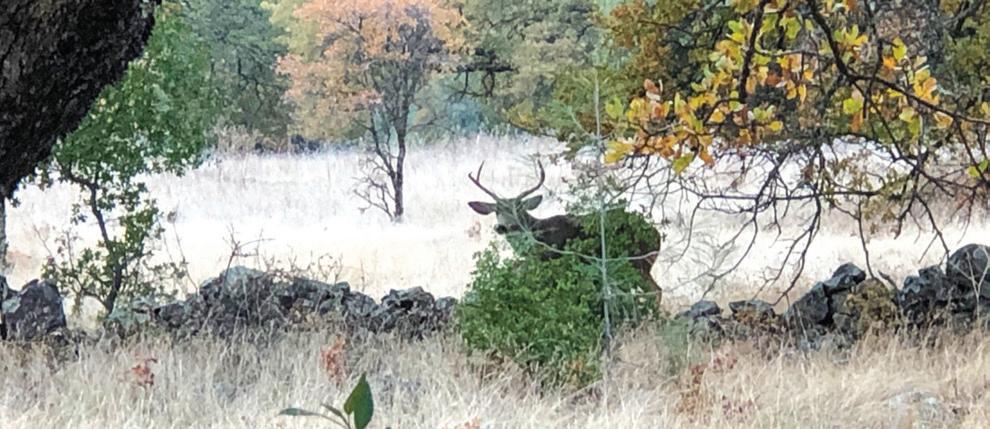

Having said that, if you put in some time selecting a location for a ground blind, you’ll do fine. I like to sit with my back against a tree with low limbs over my head. I generally position my backpack in front of myself so it’s sitting upright to provide both cover and a shooting rest when the moment of truth arrives.
I don’t want stand hunting to
be confused with glassing. When glassing in burns, you are setting up in a location to see a broad swath of territory. When stand hunting, you are establishing a stand where you expect the deer to move past, resulting in a solid shot at a reasonable distance – say, 150 yards or closer.
In a sea of forest land, where the transition between scorched

vegetation and untouched woods can run for miles, deciding where to set up can be daunting. Boots-on-theground intelligence will help pinpoint the perfect location.
By reading tracks and droppings you can dope out where the deer are likely bedding and feeding. I’ve had my best luck setting up on the edge of thick cover in an elevated position with a view of the top edge of a hollow or gully.
Once you locate a spot that gives you confidence, it’s time to test your patience. Stand hunting isn’t for everyone. The longer your stay on the stand, the better your chance of tagging a buck. I’ve set a single stand from dawn to dusk for up to seven straight days. About 85 percent of the time across my blacktail hunting career, if I ride a stand day in day out, I end up tagging a buck. That’s a good average in a state where the highest success rates hover at 20 percent in the best of circumstances.
Take note that I said dawn to dusk. Every blacktail hunter knows deer are most active early in the morning and late in the evening. The fact deer often get up around midday to reposition themselves and browse a bit is news to many hunters who spend those hours in camp, eating lunch, talking about what they saw on the morning hunt and planning their evening hunt.
I carry a small stove, plenty of water and some dehydrated meals in my pack; typically, I eat breakfast, lunch and dinner on stand. This strategy has proven especially productive on stormy, overcast days when deer can move at any hour. I’ve nailed quite a few bucks on blustery afternoons, and you can too. CS
Editor’s note: Cal Kellogg is a longtime Northern California outdoors writer. Subscribe to his YouTube channel Fish Hunt Shoot Productions at youtube.com/ user/KelloggOutdoors.











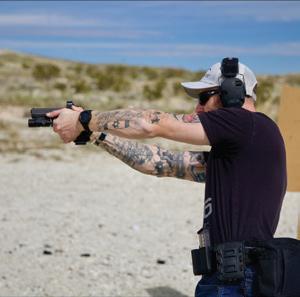








Just seeing that buck made for a good season. Could I have killed it had I been alone? Most likely. But sometimes opportunities don’t align, and it would have been the buck of a lifetime for my friend.
That year I hunted 28 days during the general rifle season in October and the first few days of November. Most of my time was spent around 3,000 feet in elevation in the Cascade Range.
It was big, rugged, heavily timbered land – what wise bucks thrive in.
The season confirmed why I consider consistently taking a mature blacktail buck to be the most challenging big game hunt in North America.
One thing I’ve learned in my more than 40 years of hunting these grand deer is this: I still have a lot to learn. Fortunately, being a full-time author I get to spend a lot of time hunting

By Tiffany Haugen
When you can’t decide between crab fries and dill pickle pizza, what do you do? Order them both! “It’s for research purposes only,” I told myself. Well, that and the fact I was on a cycling trip averaging 40-plus miles a day.
One of the things I love most about long-distance bike trips is the necessity to eat like a football player. Although my trip spanned four Eastern states, the most memorable food state was Maryland.
Marylanders are very proud of their blue crabs and their ability to pair Old Bay Seasoning with just about anything. I welcome

every opportunity to try seafood in different locations just so I can bring back new ideas for this column. And with prime crabbing months ahead in California, I thought this was the perfect time for this recipe!
The crab fries from Tony’s, a quaint, family-owned pizza joint in Williamsport, Maryland, did not disappoint. The dill pickle pizza may show up sometime soon as well, maybe with clams?
CRAB FRIES
One 24-ounce bag waffle fries or fries of choice
2 cups shucked, precooked crab meat
1 cup grated cheese (Jack, Colby or mild cheddar)
1/3 cup sour cream or Greek yogurt
2 tablespoons fresh dill or cilantro
½ teaspoon granulated garlic
1 teaspoon Old Bay Seasoning
Chives for garnish
Hot sauce
Red pepper flakes, optional
Bake fries according to directions on the package. In a small bowl, combine sour cream or Greek yogurt with dill or cilantro and granulated garlic. When fries are

done, remove from the oven and turn on the broiler. Toss fries with 1 teaspoon Old Bay Seasoning.
Sprinkle grated cheese evenly over the top of the fries and put under the broiler until cheese begins to melt. Remove from the oven and distribute crab evenly over the cheese and return to the broiler to warm up the crab (about a minute). Do not leave unattended or overcook the crab. Drizzle with the sour cream or yogurt mixture, a few red pepper flakes and chives; serve with hot sauce.
Editor’s note: For signed copies of Tiffany’s popular book, Cooking Seafood and other best-selling titles, visit tiffanyhaugen.com.


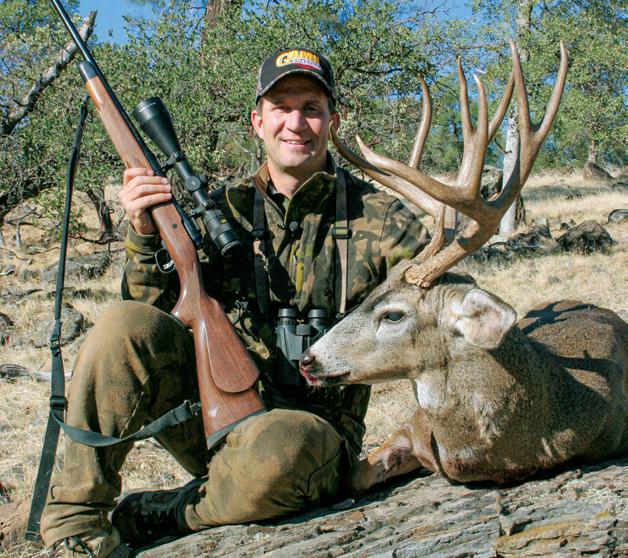
blacktails and scouting for them all year. It’s my favorite time of year.
When it comes to hunting blacktails in October, the quicker you accept the fact it’s the most challenging month to see a mature buck, let alone kill one, the less frustrated you’ll be. I’m surprised by the number of hunters who tell me there aren’t nearly the blacktails there used to be. While this may be true in some places, I think overall there are more deer out there than people believe.
Spend over 30 days of summer scouting and hunting these deer all season, along with running trail cameras year-round, and you’ll begin to see how many blacktails are really out there. Gone are the days when you can drive logging roads, glass from the truck and routinely find bucks. If you want a big blacktail, you have to work for it.
I believe blacktail bucks know the




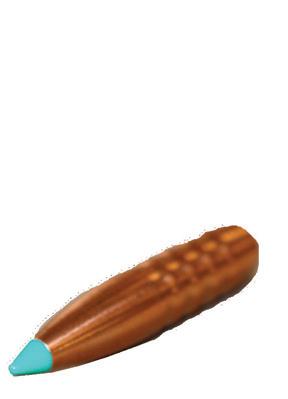



moment the opening day of hunting season arrives. They hear trucks driving and more people talking than in the past 11 months combined. An old buck knows what’s happening and instantly becomes reclusive with the increased pressure. But that doesn’t mean they’re not there.
Hunting pressure forces bucks to stick close to their core area. When pressured, old bucks will travel at night to feed and often return to bed well before sunup. Hunting closer to a buck’s core area is essential, and that means getting into the brush.
Then again, there are no set rules with blacktails. One area I hunted two years ago had been closed for two seasons due to wildfire damage. I
started scouting in July and regularly saw over a dozen mature bucks a day.
When the October opener came, my dad and I were in position, looking for three bucks I’d seen all summer. It took a couple hours, but they showed up right where I’d been seeing them, feeding their way through a burn and into a thick stand of young Douglas fir trees where they’d bed all day. Dad connected on a dandy three-point, a good buck for an 81-year-old blacktail hunter.
When hunting pressured bucks, I either set up a spotting scope on a distant ridge and try to locate a buck I can make a move on, or dive into the brush. If I’m certain a big buck is in the area, I’ll head into the thick stuff while
looking for trails, beds and doe sign.
As soon as the first storm of October arrives, get out and hunt. Hunt before, during and after the storm. A drop in temperature will activate bucks. A heavy rain will get them moving and keep them moving. Before the storm, a drop in barometric pressure will get deer active.
The later in the month a storm hits, the better. Granted, cold temperatures don’t determine the blacktail rut; waning daylight, or photoperiodism, does. But cooling temperatures do play a big part in boosting buck movement because the drop in ambient air temperature allows them to move more comfortably.
A buck will cover more ground, become active in daylight and be more aggressive toward other bucks when cooler temperatures hit. This is the time to check out the does you have located while scouting and hunting, as bucks will find them.
Cold rain is the best condition for October blacktail hunting. Not only will this cool a buck’s body temperature, but the situation optimizes the amount of scent left in the woods. The more moist the ground, the more distinct any scents left become. For a blacktail buck seeking does in heat, it smells the tracks of all deer in the area, as the interdigital gland leaves a unique identifying scent. As increased levels of estrogen become prevalent in doe urine, a mature buck will detect it, match it to the interdigital gland scent and follow it, sometimes for impressive distances.
If you don’t fill a blacktail tag early in the season, don’t give up. The later it gets, the shorter the daylight hours become, the cooler conditions will be and the more rut-crazed bucks grow. That’s the perfect combination for finding a big buck. CS
Editor’s note: To order signed copies of Scott Haugen’s best-selling book, Trophy Blacktails: The Science Of The Hunt, visit scotthaugen.com. Follow Scott on Instagram.
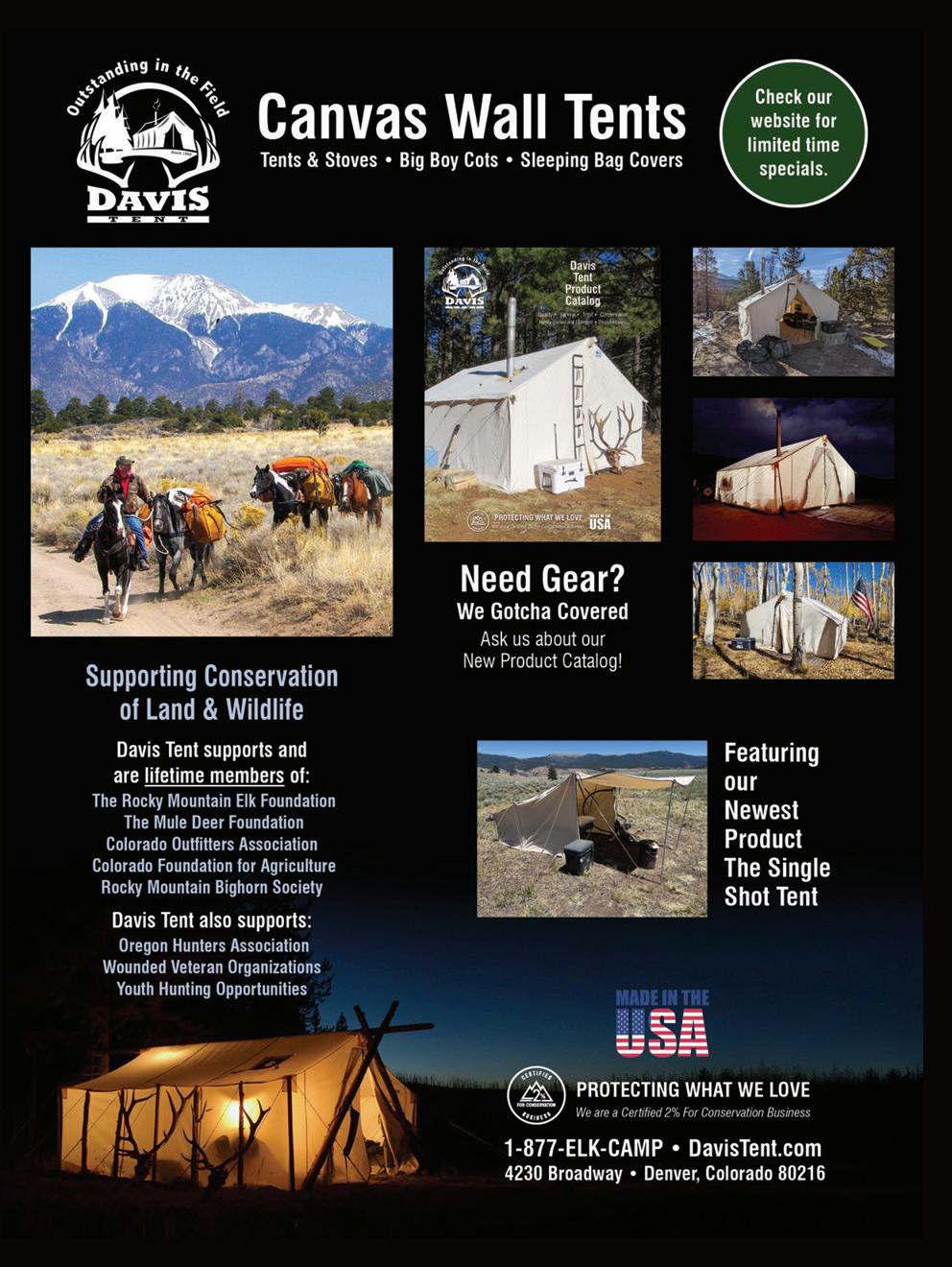
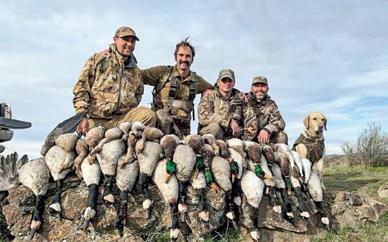


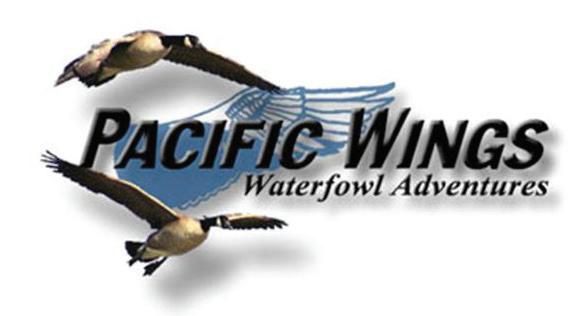
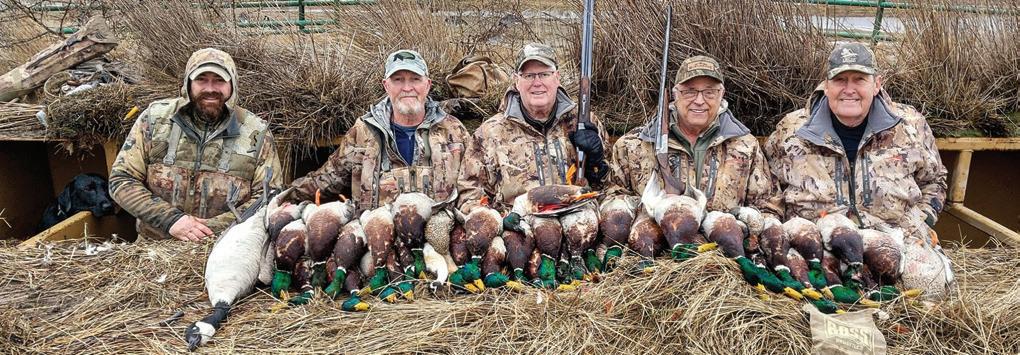





By Tim E. Hovey
Like many hunters, my introduction to the shooting sports started with airguns, which we called BB guns.
At 9 years old, I found a Benjamin pump pistol in my grandfather’s garage. After a little instruction, I was given a small tin of pellets and started plinking around his wild half-acre property in the back hills of Southern California.
Seeing my interest, my dad wrapped up a break-barrel BB gun and stuck it under the Christmas tree the following year. With a brief safety lesson from my dad, I was out hunting our property in Central California. I don’t recall the brand name of the airgun, but I learned proper aiming and trigger squeeze shouldering the heavy BB gun. I used that present so
much that it eventually fell apart in my hands.
From there I acquired a Crosman pump pellet gun in .177 caliber at a garage sale. My dad put me to work tackling the rats that gathered near our chicken coop eating their feed. When I turned 18, I shelved the air rifles and moved on to real firearms and never really gave air-powered firearms a thought. That all changed in 2022.
FOR THE LAST FEW years, my good friend Eric Mayer has been trying to get me to pick up one of the new airguns out on the market for ranch work. I have access to a few properties and their ranchers are always wanting me to tackle their pigeon and Eurasian dove problems. Due to the location of the properties, small-caliber rifles are out of the question. With no other choice,
Eric and I met at one of the properties with a couple of his air rifles.
At the tailgate, Eric walked me through the specifics of the air rifles we’d be using for the day. I was aware that air rifle designs had made tremendous strides in power and accuracy over the last several decades. However, I was about to be pleasantly surprised with the ease of use and accuracy of those Eric brought. Both rifles were precharged pneumatic, or PCP, airguns. This means they carry a carbon fiber tank under the barrel that charges the airgun with pressurized air. Eric was using a .25-caliber LCS Air Arms air rifle, and I was using a Daystate Huntsman in .22 caliber. Neither rifle looked anything like the BB guns I used when I was a kid.
We spent the afternoon hunting

the dairy property for Eurasian doves. While I was impressed with the consistent power of the .22-caliber pellet rifle, the accuracy of the Huntsman was absolutely amazing. At 50 yards out, I was consistently placing a pellet in a quarter-sized target and easily dropping birds. Despite being a little heavier than the rifles I was used to using, I really enjoyed plinking around the property with the air rifle.
AFTER THAT FIRST TRIP, I decided that I needed an airgun of my own. Using Eric’s expertise, I decided on an FX Panthera PCP air rifle in .25 caliber. I also picked up a filler tank to charge the Panthera.
Today’s air rifles are built well and are beyond accurate. Out of the box, I sighted in the Panthera and was able to put 10 pellets inside a dime-sized target at 40 yards. The muzzle velocity is steady at 900 feet per second, and it has plenty of power for hunting small game animals.
Many models come with pellet magazines and charging handles that advance the next pellet and air charge. Honestly, to prepare for the next shot is as easy – if not easier – than working a bolt on a

conventional rifle. The FX Panthera magazine holds 16 .25-caliber pellets, and I can usually get through three magazines before I need to hook up the filler tank and refill the air rifle.
AIRGUN HUNTING RULES IN California are surprisingly open. Both small game and nongame animals are legal to hunt in the Golden State with any type of air rifle. Open-game species include cottontail rabbits, jackrabbits and tree squirrels. All species of upland game,

including pheasant, turkey and quail, are also legal to hunt with an airgun in California. Add in nongame species like Eurasian doves, starlings and pigeons, and airgun hunters can stay busy just about year-round.
On that first trip to the dairy, Eric and I were able to drop almost 30 Eurasian doves. Roger, the rancher, saw our first day’s haul of birds and quickly asked us when we’d be back. He explained that each bird will take a fist-sized amount of grain twice a day, which seriously impacts his bottom line. Eric and I gladly made plans to return soon.
The following week I decided to head out and actually hunt public land with the airgun. With cottontail season well under way, I decided to hit one of my favorite rabbit spots and give it a try.
After arriving early, I set up with the sun at my back and waited. I was on a mound overlooking a sage-covered area filled with rabbit droppings and within minutes a cottontail popped out from behind a bush at 40 yards. I eased the shooting sticks over, found the rabbit in the scope and squeezed the trigger. The rabbit tipped over dead. The quietness of the air rifle kept the other animals calm. I ended up dropping one more rabbit before heading back.
Over the next year, anytime I headed out to hunt, the airgun was


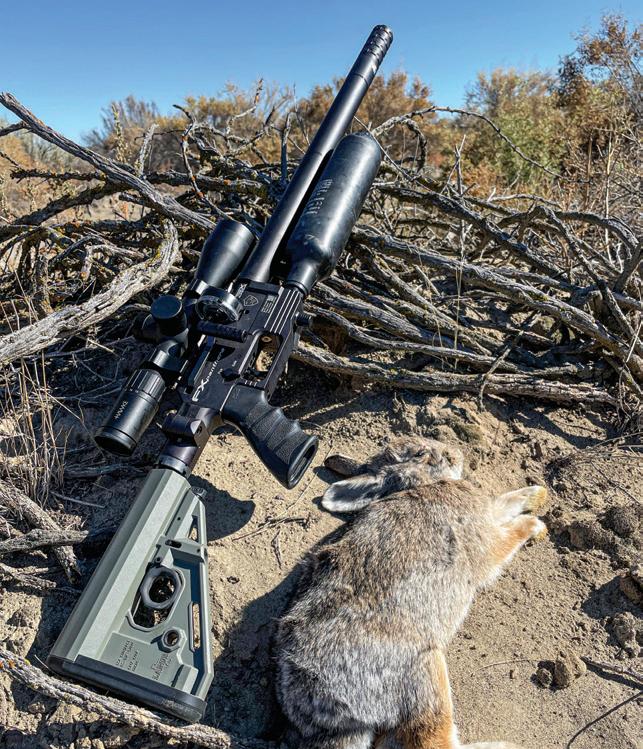
“If
loaded up in the truck. I chased upland birds – both game and nongame varieties – and thoroughly enjoyed my time outdoors hunting with the air rifle. It honestly took me back to those early days when I just started shooting – only this time, the toys were a lot nicer.
Now, Eric and I talk a lot about airguns and accessories. We hunt the dairy when we have time, as we have an open invitation to help Roger out whenever we can. The more desired targets are pigeons and Eurasian doves, and we have dropped a lot of them.
IT’S ALWAYS A GOOD idea to check on the state and county hunting regulations before you head out for a hunt. Some species are open for hunting with an air rifle, and some aren’t. With all the specific regulations out there, it’s best to make sure you understand the rules before heading afield
Today’s airguns are a lot different than those childhood BB guns most of us think of. They are sophisticated devices capable of delivering a pellet of varied sizes with incredible accuracy and short-range hunting velocity. They are easy to use and very fun to shoot. If you’re thinking of hunting a little differently, check out the new age of air rifles currently out on the market. Just keep in mind that these are definitely not your grandpa’s BB gun. CS










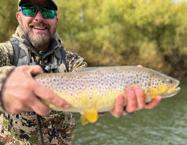

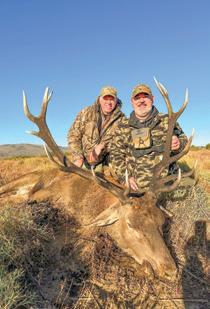



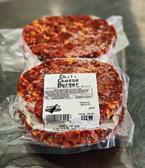
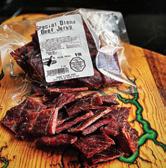

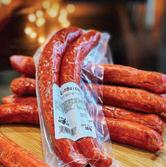
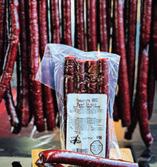





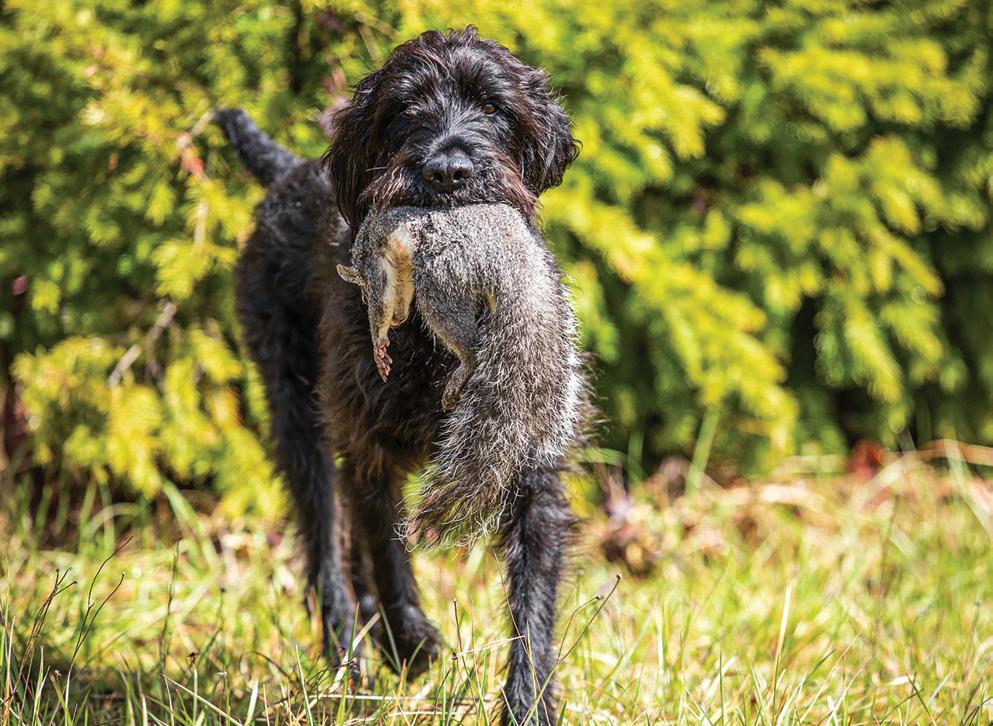
By Scott Haugen
If you own a versatile gun dog, you know what I mean when I say the tone in their bark and their level of enthusiasm hits another level when hunting fur. Pointing birds is
great. Hunting waterfowl is hard to beat. But when that dog gets a whiff of a squirrel, the chase is on.
For Kona, my male pudelpointer, his favorite hunt is for native Western gray squirrels. He almost always sees them before I do. When cut loose he
chases them through the forest as fast as any animal I’ve ever seen run. And when he finally trees one, his manbark kicks in.
The addiction to hunting gray squirrels runs year-round. Though the season for Westerns is relatively brief
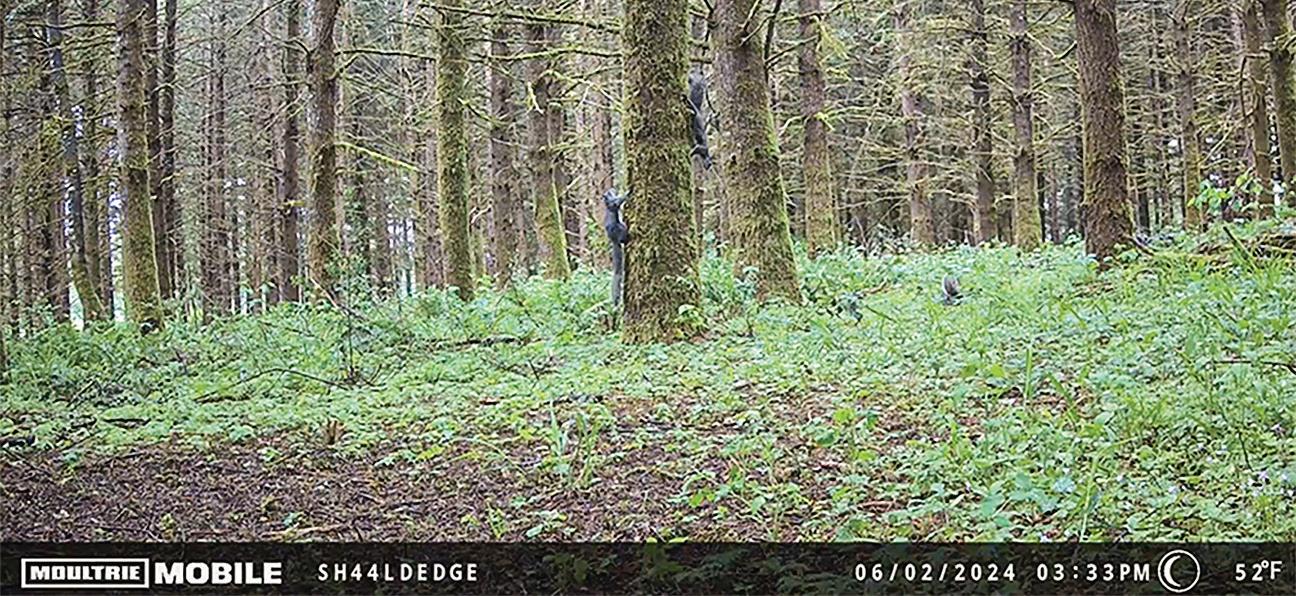
in some hunting areas, I still run trail cameras to monitor their movements and populations all year long. I rely on Moultrie Mobile cellular trail cams to provide me with immediate feedback of where squirrels are, and this is especially important this time of year. Changing food sources will often cause tree squirrels to move areas. Having hunted gray squirrels for several years, and using the information from trail cameras to monitor their movements, I’m amazed how precise and cyclical they are from year to year, changing season to season. These movements are based on a shift in food availability. In some of my top hunting areas I know
Native Western gray squirrels are bundled under the California Department of Fish and Wildlife’s “tree squirrels” category, which includes native Douglas squirrels and invasive eastern gray and eastern fox squirrels. This season they are open for harvest in most of the state outside of Southern California and Eastern Sierra counties September 14-January 26. The daily and possession limits are both four. –CS
where gray squirrels will be this time of year based on acorn and other mast crops dropping, what routes they travel in the forest, and where they search for food in big stands of Douglas fir trees. These are the places where I increase the number of trail cameras during hunting season.
WORKING OVERGROWN ROADS IS how we often find success. Once a squirrel is spotted, Kona is let loose to do his thing.
In an effort to cover more ground the past two seasons, I’ve turned to a QuietKat electric bike. These e-bikes are silent and allow me to cover ground much faster than on foot. I’ve used them with success on remote logging and farm roads, when traveling horizontal ridges in the Cascades and when hunting in semiopen hill country. They’re fast, quiet and Kona can keep up with me – or should I say, I can now keep up with him. The QuietKat’s pedal assist is great for pulling hills and the battery life has always lasted the duration of our hunts. Just be sure and take extra water for your dog when hunting on an e-bike, as they’ll cover several miles a day and need to stay hydrated. Some areas I hunt where deciduous
trees meet conifers are thick with trees and brush. There are lots of squirrels in this habitat, but stalking in on them can be a challenge, and once they tree, the shooting window is brief before they seek thick cover to hide in.
When hunting these tree lines I rely on the Moultrie Mobile trail cameras for information. I run all trail cameras on video mode, as a 15-second video clip reveals more than a photo ever can. Case in point. Not long ago a thumbnail of one gray squirrel popped up on my Moultrie Mobile app. I requested the video to see which direction the squirrel was heading and maybe get a peek at what it was feeding on. A few minutes later the video clip revealed five gray squirrels working the forest floor. That’s when it’s time to get hunting.
If I know there’s a squirrel in a mix of coniferous and deciduous trees, I’ll slowly move in with Kona heeling. If there’s a time of day when squirrel movement is high based on what trail cameras are conveying, I’ll slip in a couple hours ahead of that time and sit against a fat fir tree with Kona at my side. We sit where visibility is maximized and when a squirrel is spotted, Kona gets to work. Kona

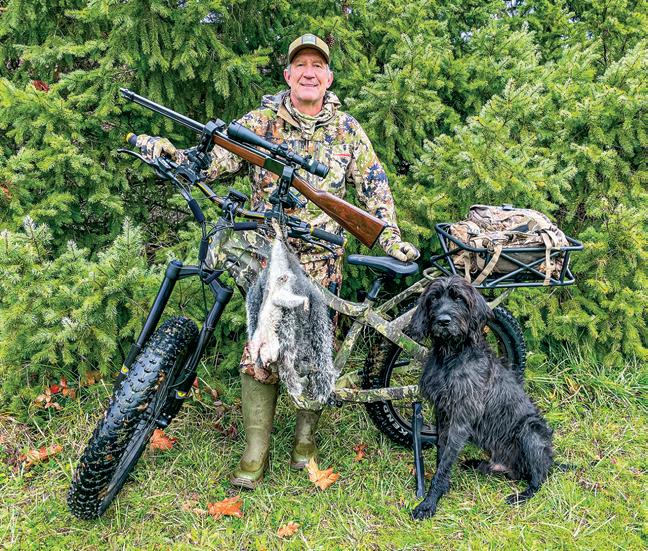

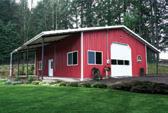

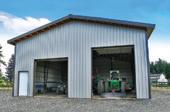
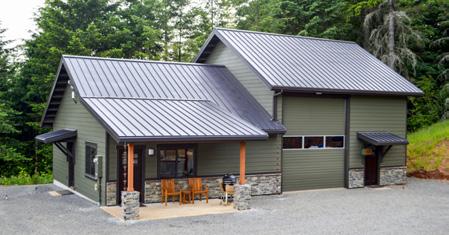
almost always sees one before I do.
IF SHOOTING IN THICK cover, a .410 might be the best gun of choice. I like tungsten loads over standard loads, as their pattern is much more dense and their killing power greater. If the habitat is semi-open and the trees not overly tall with thick, brushy limbs, then a .22 will suffice. I like shooting a scoped rifle for more precise shooting – gray squirrel is excellent eating, so you want to damage as little meat as possible. Note that California’s lead ammo ban extends to squirrels too.
Gray squirrel hunts aren’t easy, but they’re a blast. And once your pup proudly delivers a big gray to hand and instantly snaps back into hunt mode, you know they’re enjoying it as much as you are – likely more. CS
Editor’s note: Watch Scott Haugen’s basic puppy training videos and learn more about his many books at scotthaugen.com. Follow his adventures on Instagram and Facebook.



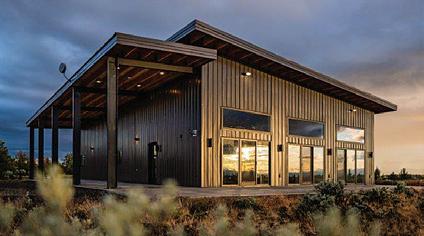


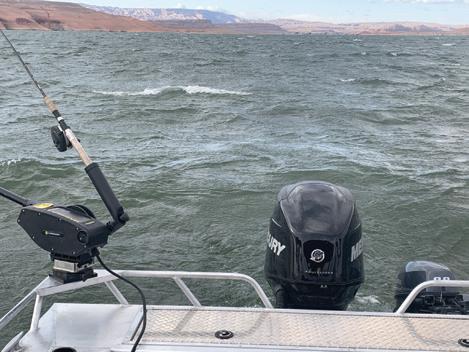
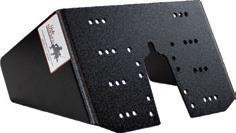








PROSPECTING FOR RAINBOWS AND GOLD IN THE MOTHERLODE

By Cal Kellogg
When the late-summer sun slipped behind the ridge, light was replaced by shadow. What had been a bright, warm afternoon with a breeze out of the west was giving way to dusk. The air cooled and became still.
This transition marked the beginning of the magical period when stream trout abandon the hiding places they’ve occupied all day to feed on caddisflies and other insects until darkness fully engulfs the stream.
Looking up the canyon toward the rusting remains of a 1920s-era suspension bridge constructed by nameless and long-forgotten miners, I saw the first few caddis of the evening fluttering against the descending thermals and knew the stream’s wild rainbows would be rising soon.
It was time to finish the soda I’d been sipping and stow my prospecting gear, but first I wanted to have a look at the gold I’d scored. I dipped some water into my lucky 10-inch pan, dumped the contents of my suction bottle into it, swirled, tapped, swirled some more, and I was greeted by a glimmering seam of beautiful gold!
I estimated there was probably a half
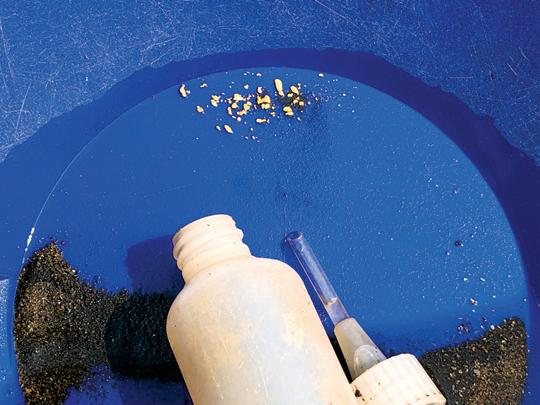
gram of gold in the pan; not a bad total for three hours’ work with just a pan and a few simple hand tools. I wasn’t rich, but with gold selling at $2,500 an ounce the flakes add up quickly.
Ten minutes later, I had all my gear back in the daypack and was stalking upstream in my hip boots with a fly rod in hand. It was time to introduce the trout to a size 12 Elk Hair Caddis!
The first trout was resting in a pocket of nearly still water behind a good-sized rock, with twin runs of bubbling whitewater to either side. The rainbow blitzed the fly as soon as it hit the water and safely spit the counterfeit caddis out just as quickly.
“Concentrate,” I told myself. I was ready when the next rise came six
casts later some 20 yards upstream. I saw a slight flash a nanosecond before the trout grabbed the fly with a splash.
A lifetime of fly-fishing instinct took over. The left hand stripped line; the right hand drew the rod tip up, sharply setting the hook, the line came tight and I instantly felt the fury of a pint-sized predator that had never encountered a hook before.
When you’re conditioned to fighting reservoir trout, you forget how strong and savage wild stream trout can be.
First, the 10-incher shot skyward with its tail pumping frantically against the air. As soon as it splashed down, it ran downstream and pulled a couple feet of line off the reel.
I turned the rainbow back upstream and intended to lead it into a pocket of still water for a quick release, but the rainbow was having none of it. The fish bolted passed my position, running against the current and made another wild jump in hopes of freeing itself.
As I worked to remove the hook from the rainbow’s mouth, I was struck by the beauty of its heavily speckled green/blue back that gave way to the iridescent pink/purple stripe that was its namesake.
With gold for the taking and wild rainbows having never encountered an angler, you are undoubtedly
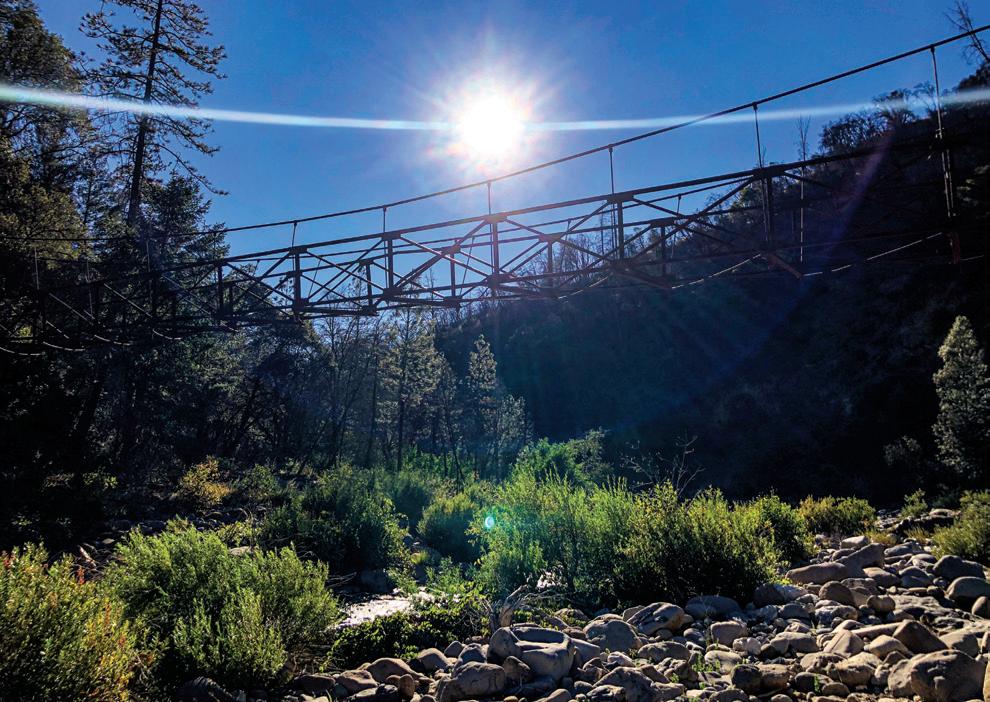







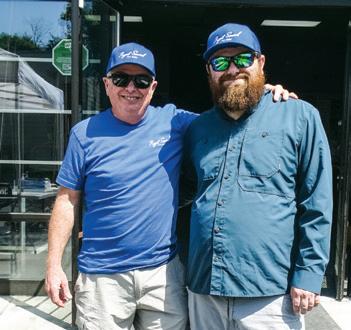

wondering where the action I’ve described took place. Was it in British Columbia? Alaska? The Cascade Range in northern Washington State?
It could have easily taken place in any of those destinations, but it didn’t. I was prospecting and fishing in a small Sierra stream almost in the shadow of the state capital in Sacramento!
Readers of California Sportsman know me as a full-time trout angler and part-time hunter, but few folks know of my other life as an avid gold prospector. When I tell people I’m a prospector I’m often confronted with the same question, “Is there any gold left in California?” Well, California is called the Golden State for good reason. The California “Motherlode” in the central part of the state and the “Gold Country” district to the north represent one of the richest goldproducing regions in the world.
Geologists at the United States Geological Survey estimate that only 20 percent of California’s gold, some
118 million troy ounces, has been extracted. This means there is nearly 500 million ounces of gold waiting to be found by you and me!
And what about trout fishing in California’s gold-producing regions?
I first went gold prospecting with my folks in the late 1970s; not long after that I caught my first trout on a fly rod. While I spend a lot of time chasing trout with traditional gear these days, there was a period of about 10 years when I fished exclusively with fly tackle, and I still love battling stream trout on fly gear.
The west slope of the Sierra hosts a maze of streams with gold, from big brawling rivers like the American and Yuba to tiny nameless tributaries. Almost all these waterways are home to trout, so strapping a fly rod to my pack when I head out prospecting is a no brainer.
The trout you encounter in the
Sierra’s rivers and streams aren’t the big-bellied planters you find in the state’s reservoirs. They are largely wild fish – sleek and rambunctious, with a lineage stretching back to the last ice age. This is particularly true if you get off the beaten path and visit some of the more remote streams draining out of the high country.
Most of these small waterways are seldom visited by people, and when a human does arrive on the scene, it’s usually in the form of a prospector or hunter, so the likelihood of catching trout that have never seen a hook is very real.
If this sort of adventure appeals to you, keep on reading while I unfurl the basics of prospecting and fly fishing where there is gold in the water!
Panning for gold is a simple, easily learned process. Gold is extremely dense and heavy, making it hands down the heaviest element you are
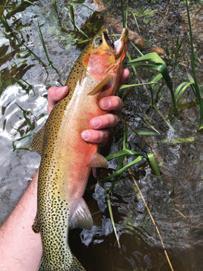
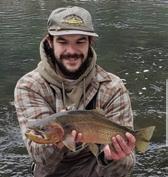



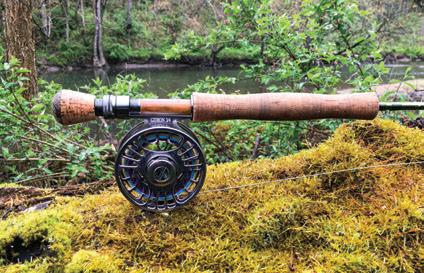

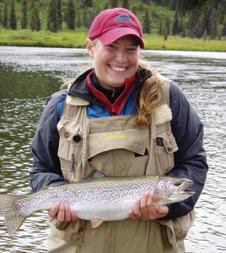
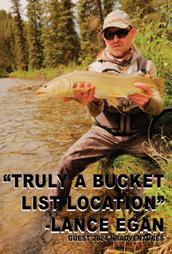



likely to encounter in a stream. And it’s the density of gold that makes gold panning possible.
When you put the dirt, gravel and sand you find in a stream along with some gold in a pan, as soon as you liquify the material and shake the pan, the gold sinks to the bottom. All modern plastic pans have a series of riffles along the side of the pan. These riffles give the gold a place to settle as you “pan” the “paydirt” you put into your pan.
I’ll give you a down-and-dirty panning tutorial in a bit, but first let’s consider the tools you need and where you’ll find the aforementioned pay dirt.
To find and capture gold quickly and easily, you only need three things: a plastic gold pan, a crevice tool and a suction bottle.
Gold pans come in a variety of sizes; 14 inches is standard, but I prefer a 10-inch model. While you can process more material with a 14inch pan, I like the light nimbleness of the smaller pan.
A crevicing tool is simply an
instrument to probe into small areas where gold likes to accumulate along the stream bed. You simply use the tool to pull out and scrape up the material you’ll later pan.
Some folks use bent screwdrivers or old butter knives for crevice tools, which work great, or you can spend $10 or so for a professionally made model. I prefer the latter.
The suction bottle is simply a screwtop plastic bottle with an extended straw coming out of it. When you see gold in your pan, you squeeze the bottle, line the straw up with the flake of gold, release your squeeze and shazam: the gold is sucked up and into the bottle, safely captured.
While the density of gold makes the metal “pan-able,” it also causes gold to accumulate in specific areas along the streambed. Due to its density, gold always works its way down through other materials like sand and gravel until it meets a solid barrier. In nature this solid barrier is almost always bedrock.
Bedrock, or country rock, is those big expanses of solid rock you see
next to a stream. This is the rock that underlies everything.
When looking for gold, simply locate an expanse of bedrock and look for any cracks or pockets in the rock. When you find one, use your tool to dig out all the material and put it in your pan. When your pan is twothirds full, it’s time to give it a whirl. Go to the stream and dip the pan under the water. Use your fingers to work the material to ensure everything is wet. Next, jiggle the pan back and forth for several seconds. This will put any gold in the material on the bottom of the pan. The next step is to tilt the pan 30 degrees or so and move it back and forth in the water while slowly washing lighter material out of the pan. Every 30 seconds or so repeat the jiggling to resettle the gold; think jiggle, wash, jiggle.
When almost all the material has been washed from the pan, scoop up some clean water and swirl your remaining material around. If there
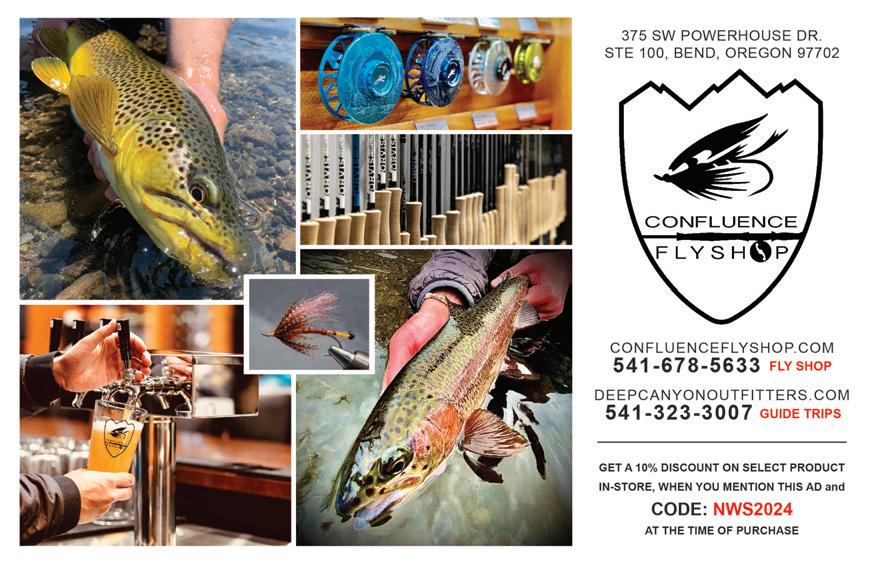

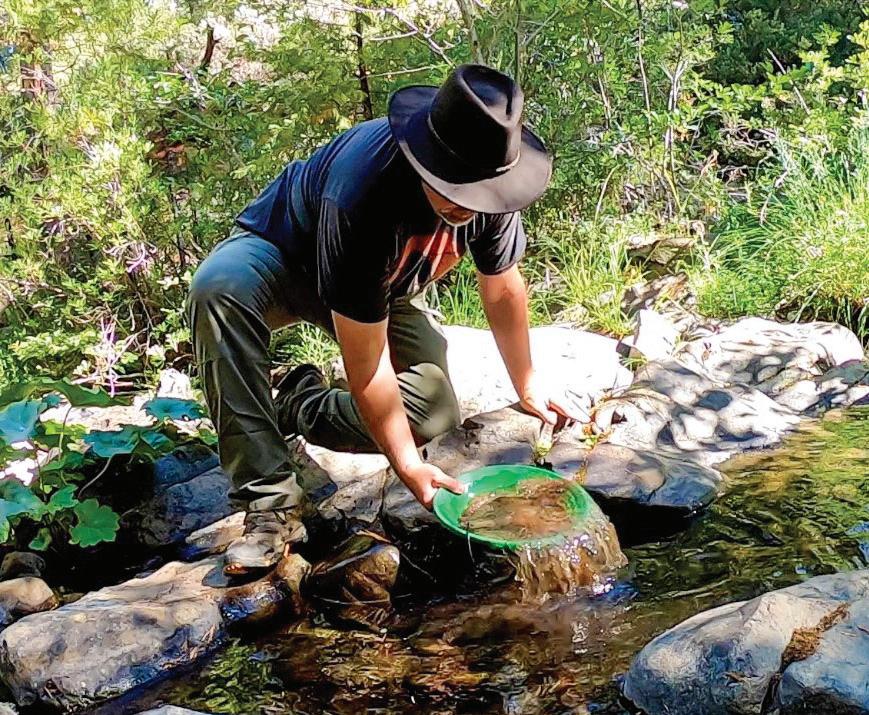
was gold in the paydirt, you’ll see it in the pan.
If you want to practice panning, split shot is a good substitute for gold. If you are a visual learner, there are hundreds of gold panning demonstrations on YouTube.
I know gear anglers are intimidated by the term “fly fishing.” Asking a gear angler to go fly fishing is akin to asking Count Dracula to go sunbathing! If this describes you, I want you to empty your mind, breathe deeply and trust me. Not only is fly fishing easy and super fun, but it’s also a super effective way to catch trout on small streams.
Yes, there are big rivers full of educated trout where fly fishing is really technical. Playing golf at Pebble Beach is difficult and technical; miniature golf? Not so much. Small stream fly fishing is like miniature golf. On a small stream, if you can flip a fly out into the water, you are well on your way to fly-fishing success.
A lot of folks think fly fishing is
expensive, and it certainly can be, but I just looked at the Bass Pro Shops website, which features rod, reel and line combos starting at about $40. With that setup, a premade tapered fly leader and a dozen flies, you can catch a bunch of wild rainbows and some bonus browns and brook trout while exploring the small streams flowing down the west slope of the Sierra.
As with gold panning, go to YouTube and watch a few videos that outline basic fly casting, then head outside and get in a bit of practice on your lawn. When it comes to casting distance on small streams, less is more. I seldom have more than 20 feet of line out, including the 7-footlong leader.
To catch the maximum number of trout, subsurface flies are more effective than dry flies that ride atop the water, but catching the trout up top is way more fun. I carry a small box of subsurface nymphs and subsurface flies with me. But in reality, I do 90 percent of my small stream fishing with dry flies because it’s always way more fun to catch fish
on topwater offerings.
On streams where the trout are “educated,” matching the hatch is very important. Small-stream trout are highly aggressive, so I stick with flies that give the trout the impression of a nice juicy meal.
Grasshopper imitations are fun to fish, as are any flies made of deer or elk hair. Hair flies are very buoyant, ride high and dry and are easy to see
Seeing the fly is very important for two reasons. First, you need to make sure it is drifting at the same pace as the current and not dragging. If your fly is dragging, even the class dunce of the trout world won’t hit it. Second, you want to see the strike so you can set the hook immediately.
As soon as Mr. Trout gets the fly in its mouth, the trout will know he’s been duped; it will instantly spit it out. You’ve got to have the mindset of a gunfighter in a 1950s Western. As soon as the trout makes its move, you’ve got to make yours and beat him to the punch. It is amazing just how fast a trout can grab and spit out a fly!
Just about every small- to medium-sized stream flowing west out of the Sierra features the gold and trout combo. Some have more and bigger gold; the same goes for trout. Some streams have a bunch of 4- to 6-inch trout, but there are plenty of overlooked gems that boot out wild trout averaging 8 to 10 inches, including 18-inch monsters lurking in the shadows.
Your adventure starts with a map of a national forest in your region. Identify a few streams, plan your adventure and let the exploring begin. After a season, you’ll have a short list of spots that produce both trout and gold.
I’ll leave you with two warnings: Gold fever is real and fly fishing is addictive, so if you choose to follow me down this path, both activities could easily turn into lifelong afflictions. That’s because you’ll never find enough gold and you’ll always want more and bigger trout! CS




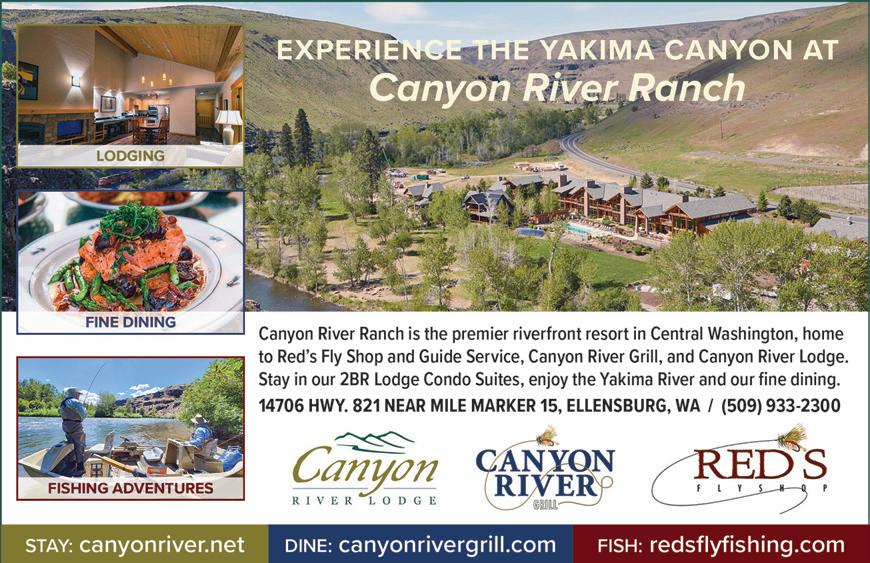






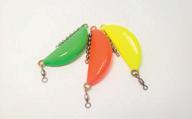

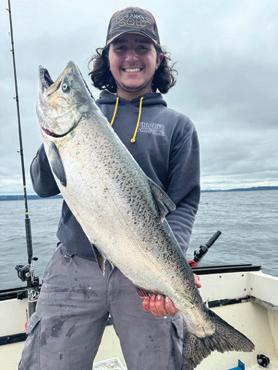
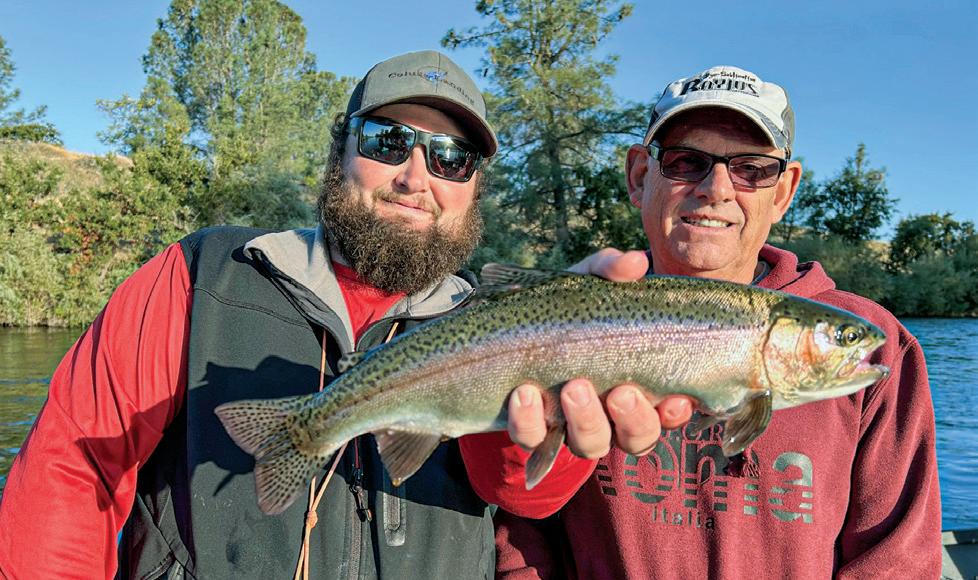
By Mark Fong
The Feather River below Lake Oroville is a diverse fishery. Perhaps best known for its striped bass and salmon runs, the river also plays host to a thriving steelhead fishery. September and October are typically the peak months of the fall season, but this is dependent on the water flow releases from Oroville Dam.
VALLEY’S UNTAPPED GEM
The Feather has a mixed of wild and
hatchery-raised steelhead.
“About 80 percent of the steelhead are hatchery fish,” says local guide Dakota Townley. “We get a few fish up to 8 to 10 pounds, and a lot of them range from 3 to 6 pounds, as well as a mix of half-pounders. The limit is two hatchery fish, and all wild steelhead are released.”
According to Townley, the Feather River is an underrated steelhead fishery. He primarily targets the
stretch below the Thermalito Afterbay Outlet all the way downriver towards Gridley.
“I think (the Feather River) is a great introduction to steelhead fishing,” he says. “I’ve done a lot of coastal steelhead fishing where you’re fishing all day, with (getting) maybe, if you’re lucky, five or six bites. These are wellknown fisheries like the Eel, the Smith and the Chetco in southern Oregon. On the Feather, you tend to get a lot of
action, and limits of hatchery fish are more the rule than the exception.”
For anglers who live in the Central Valley, to have such a great fishery within a relatively short drive is truly a gift.
“When I was guiding on the coast, that was always a tough deal because guys would drive six or seven hours and then it would rain all night and boom, all of a sudden the water was blown out,” Townley explains. “The Feather is all dam-controlled water, and for the most part you know what you are getting as far as the water flows.”
Once the steelhead arrive, they start milling around and getting on the runs and looking for food. Early on they will feed heavily on insects, but once the salmon arrive in the river and start to spawn, the steelhead will sit downstream of the redds and eat salmon eggs. This is when the action becomes very consistent.
Over the years I have fished the Feather for salmon, striped bass, shad and smallmouth bass, but never for steelhead. Recently, my fishing buddy Ian Rigler and I had the opportunity to join Townley and his longtime friend, mentor and fellow guide Brett Brady for an early-season scouting session.
After launching his Willie Legend jet sled, Townley idled away from the ramp and gave us the rundown on the day’s fishing. He explained to us that we would be drifting roe on light spinning gear.
While the Feather may not have the top-end grade of fish found in some of the coastal rivers, a steelhead is a steelhead no matter where it swims. Townley likes to size down the gear and utilizes a Kevin Brock 7-foot, 6-inch 4- to 8-pound spinning rod paired with a Daiwa 2000 reel spooled with 8-pound-test monofilament line.
He’ll use that gear accordingly to allow his clients to fully experience the hard-fighting fury and wild acrobatics that steelhead are known for.
Once we cleared the no-wake zone, Townley hit the throttle and we sped downriver to our first spot of the morning. Positioning the boat above the riffle, Townley instructed us where to cast. Several drifts and repeated casts yielded no takers, so it was off to the next hole. When we reached our second stop, it did not take long for Brady to hook up with a beautiful Feather River steelhead. He had a spirited fight, and after a quick scoop of the net the fish was released to fight another day, an exercise that Brady has clearly performed countless times.
As the morning unfolded, Townley continued to move from spot to spot


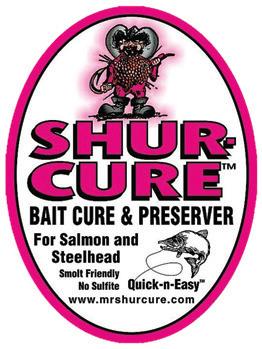
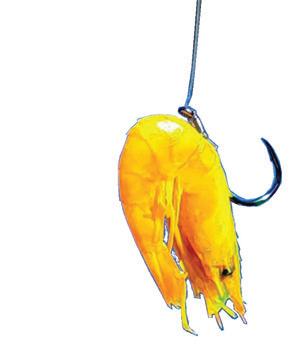
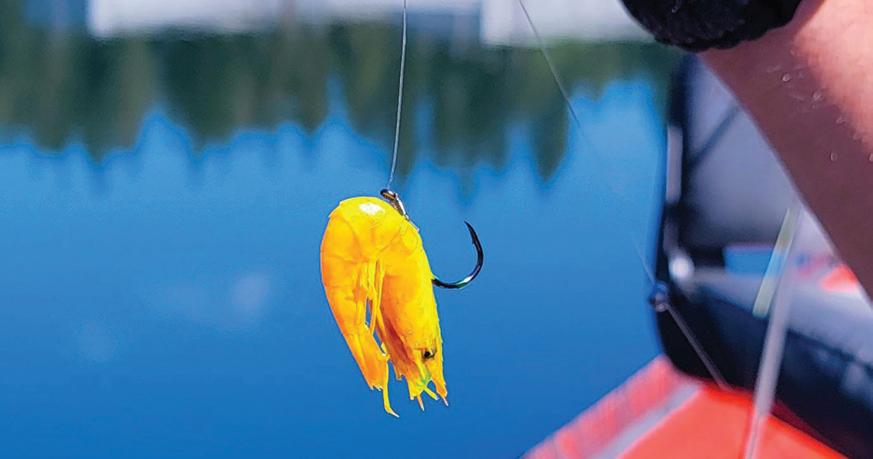
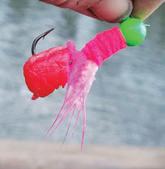



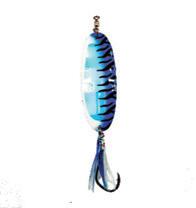
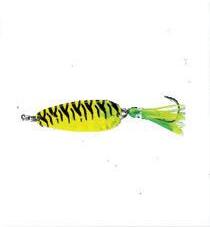



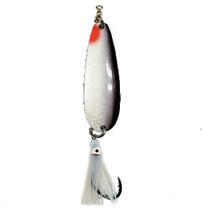



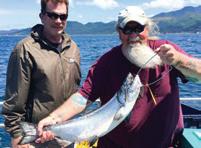

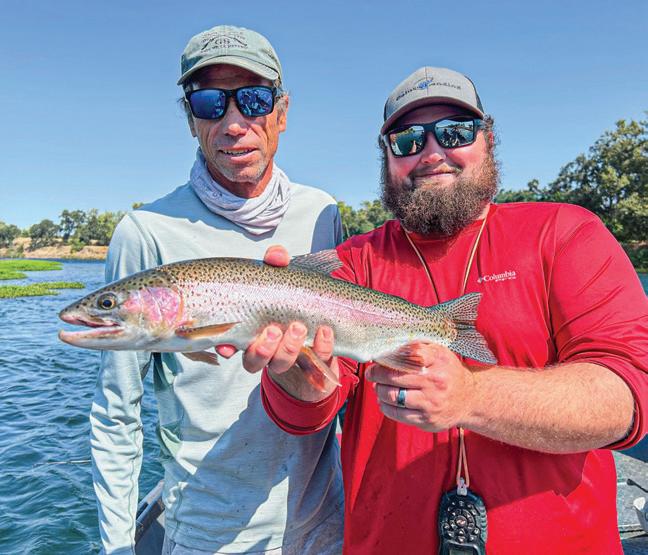
“I think (the Feather River) is a great introduction to steelhead fishing,” Townley (right, with Brett Brady) says. “On the Feather, you tend to get a lot of action, and limits of hatchery fish are more the rule than the exception.” (MARK FONG)
on the lookout for concentrations of fish. While we did not catch steelhead in every location, there certainly was plenty of action, as the pikeminnows and suckers also showed quite a liking for our bait.
The highlight of my day came when I hooked into my first Feather River steelhead. It put on quite a show as it went airborne and then took off on a number of spirited runs before I could bring it boatside for Townley to net.
By the time we got off the water at noon, we had caught and released a dozen or more steelhead, mostly hatchery fish with a few wild steelies in the mix as well. I certainly had a great time and I can’t wait to fish the Feather again. CS
Editor’s note: To book a trip with Dakota Townley’s Guide Service or to learn more, you can follow him on Facebook (facebook.com/dakotatowney) or contact him directly at (530) 680-3717.



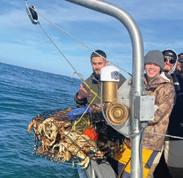
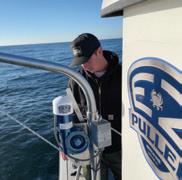

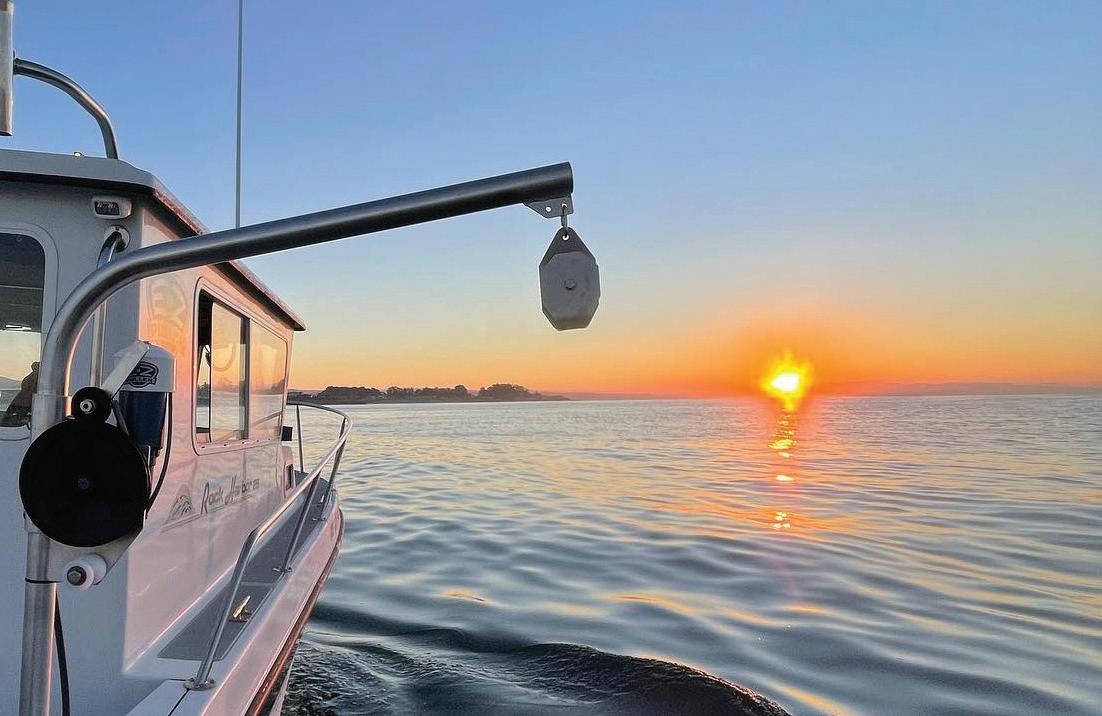

2.8L
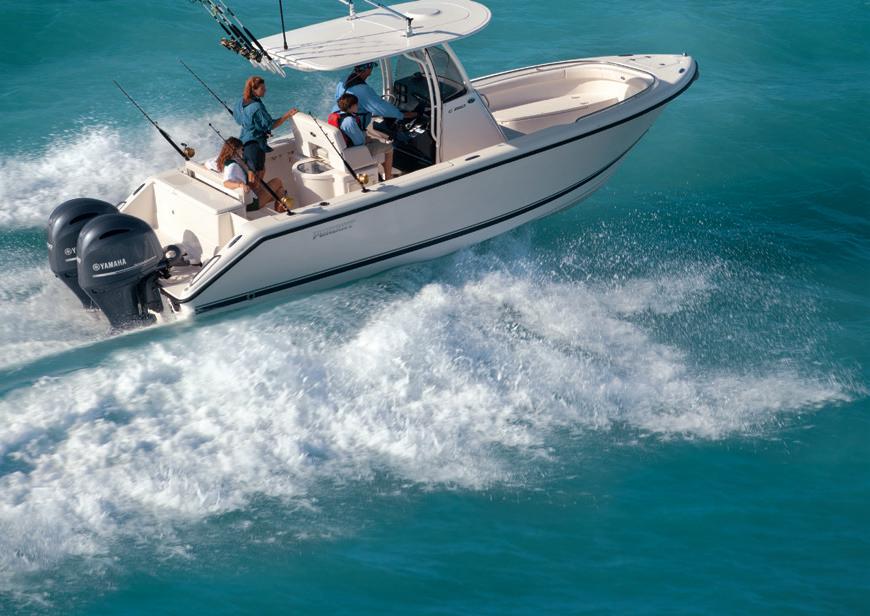












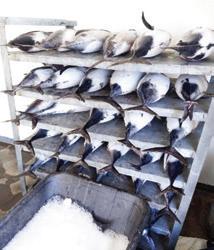
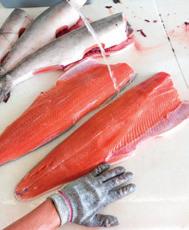

★ New patented EASY to use Bobber With A Brain Jr., ONLY automatic slip bobber in the world that requires no line stopper! You can fish 1 & 2 feet off the bottom automatically any depth, even 50 feet deep and it will not drift in 30 mph wind or jet ski waves!
★ Works in combination with any slip sinker and allows you to fish on and off the bottom at the same time on the same crappie or perch type rig!
★ Sold in three packs on e-bay and website: BobberWithABrain.net or SmartestTackle.com
★ Questions answered by Frank, inventor at Stackle23@msn.com


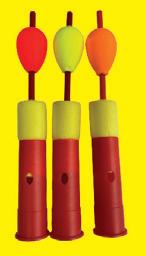


Located along the rugged Humboldt County Lost Coast, Gyppo Ale Mill and its beers reflect founder Julie Peacock (with rockfish) and her husband Josh Monschke’s love for fishing and the Shelter Cove community they call home. (GYPPO ALE MILL)
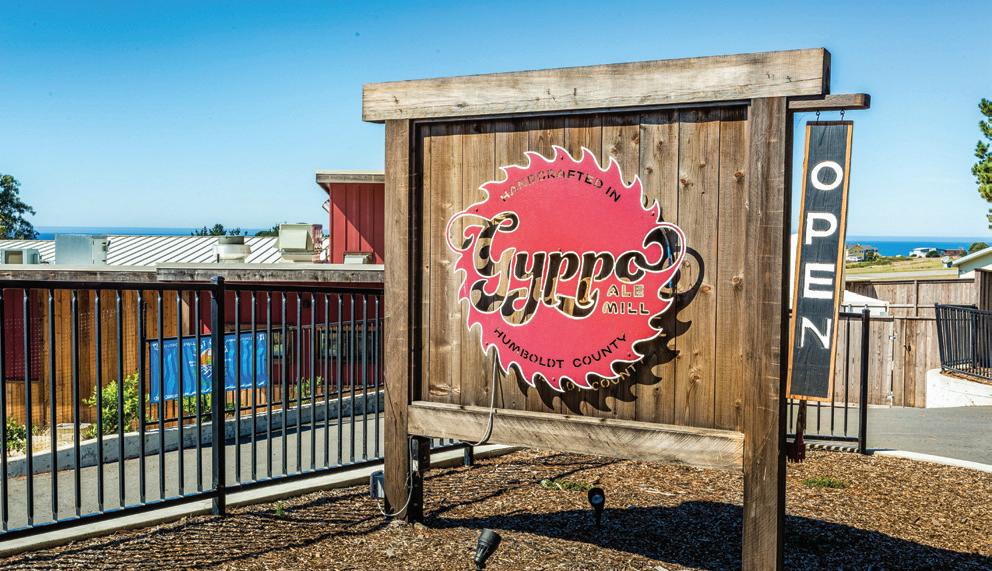
By Tiffany Herrington
On any given day, Gyppo Ale Mill’s founder Julie Peacock might be found roaming the rugged trails of Northern California’s Lost Coast or working diligently behind the brewery’s taps. With a name inspired by the resilient “Gyppo” loggers and a dedication to the untamed spirit of the region, Gyppo Ale Mill (707-986-7700; gyppo.com)

embodies a unique blend of tradition and innovation.
“I strive to capture the essence of our land in every brew,” Peacock says. “Our beers are a reflection of the rugged beauty and rich history of the Lost Coast.”
We chatted with the brewery’s founder to delve into the captivating story of Gyppo Ale Mill – from its origins in Pacific Northwest logging
traditions, to its role as a vital part of the Lost Coast community.
We’ll also explore how its remote landscape influences their distinctive brews, drives their sustainable practices and shapes their communityfocused initiatives. As Peacock puts it, “We’re not just brewing beer; we’re celebrating the spirit of our land and its people.”
Gyppo Ale Mill’s deep connections
with local fishermen, farmers and outdoor enthusiasts fuel their commitment to sustainability and local collaboration. Julie unveils the stories behind the brewery’s celebrated beers, their efforts to support the local community and their vibrant role in the Lost Coast’s outdoor culture. Find out how Gyppo Ale Mill blends craft, community and the untamed spirit of the Lost Coast into every pint they pour.
Tiffany Herrington Gyppo Ale Mill is known for its unique connection to the outdoors and the local community. Can you share the story behind the brewery’s name and its founding, and how being located on California’s remote “Lost Coast” has influenced its identity?
Julie Peacock Gyppo Ale Mill’s name is a tribute to the independent spirit of the “Gyppo” loggers – small-scale, family-owned operations that didn’t answer to large logging companies. This reflects both my family’s and my husband’s (Josh Monschke) roots in the Pacific Northwest logging community. Our families have deep ties to southern Humboldt (County), where they operated logging mills, particularly around Building Point Road. The Lost Coast, where Gyppo Ale Mill is located, was once a vast sheep farm. My husband’s family grew up here, witnessing the transformation from isolated land to a connected community. This history of resilience and self-reliance is woven into the fabric of Gyppo Ale Mill, where we strive to maintain that pioneering spirit in everything we do.
TH How does the location of Gyppo Ale Mill in Shelter Cove influence the types of beers you produce?
JP The remote and rugged beauty of the Lost Coast profoundly influences the types of beers we brew. Our beers are inspired by the people and stories of this unique place. For instance, Dave’s Pilsner was born from the persistent requests of David Gilchris,
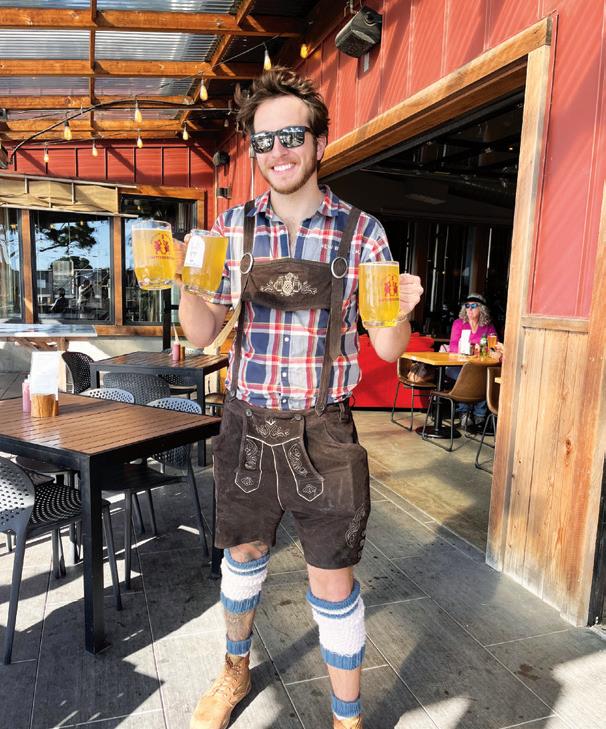
a beloved community member who embodies the local spirit. He’s not just a name on a label; he’s a vital part of our community, hosting cornhole tournaments and trivia nights, making him a true “community weaver.”
Another example is our Mexican lager, the first beer we ever brewed, inspired by the construction crew who built Gyppo and preferred (iconic Mexican beer) Pacifico. The Lost Coast’s blend of rugged individualism and tight-knit community drives us to create beers that reflect the tastes and traditions of those who live and work here.
TH Your brewery has a strong commitment to sustainability. Can you discuss some of the sustainable
practices you’ve implemented and how they align with the values of the local community?
JP Our commitment to sustainability is a core value at Gyppo Ale Mill, shaped by our location on the ocean’s edge and our responsibility as parents to the next generation. We are proud members of the Surfrider Foundation’s Ocean Friendly Restaurant certification, which requires us to adhere to strict sustainability practices. We source our seafood based on recommendations from the Monterey Bay Aquarium’s Seafood Watch program, ensuring that every fish we serve is caught sustainably. We’ve eliminated singleuse plastics, opting instead for largeformat purchases to reduce waste.
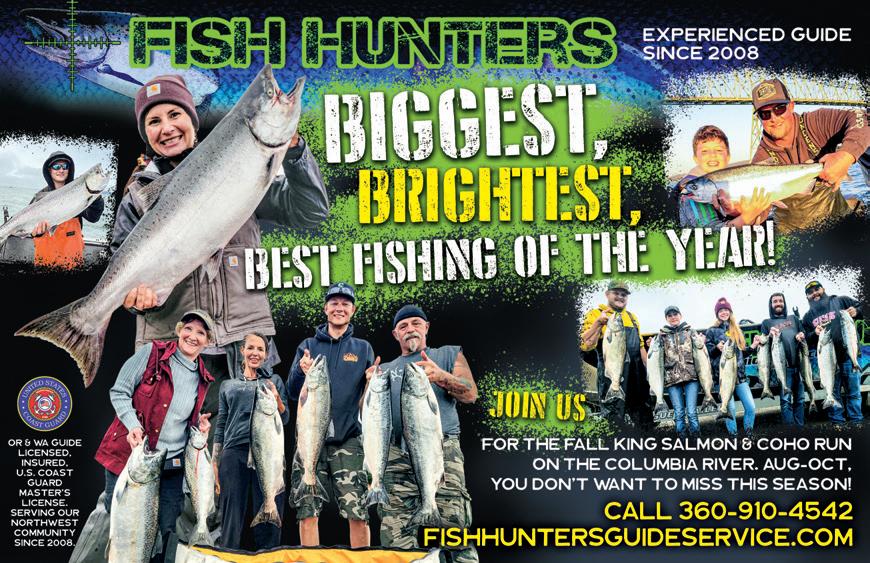

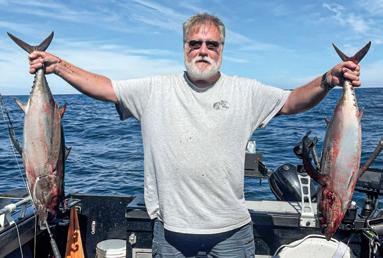

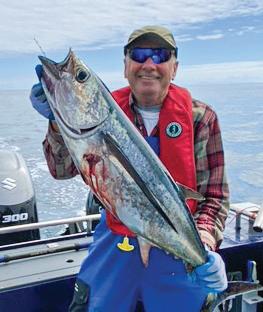
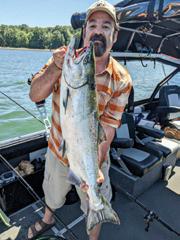
Living so close to the ocean, we are acutely aware of the environmental impact of our actions. By minimizing our footprint, we align our operations with the values of our community, who are just as committed to preserving the natural beauty of the Lost Coast.
TH Your pub’s menu features fresh rockfish for fish and chips, sourced from local fishermen. How did this collaboration come about and why is it important to Gyppo Ale Mill?
JP Our connection to local fishermen is integral to the identity of Gyppo Ale Mill. We work closely with Sam Stebnicki, who provides us with the freshest line-caught fish year-round. Whether we need 200 pounds of rockfish or a smaller catch, Sam is our go-to guy, ensuring that our menu features only the best. During crab season, we turn to Luke Sachs, who delivers fresh, succulent crabs to our kitchen.
These relationships are more than

just business transactions; they are partnerships that support local families and sustain traditional livelihoods.
For example, Sam bought his boat from Ken Vallotton, a beloved figure in the Shelter Cove community who originally ran Lost Coast Landing.
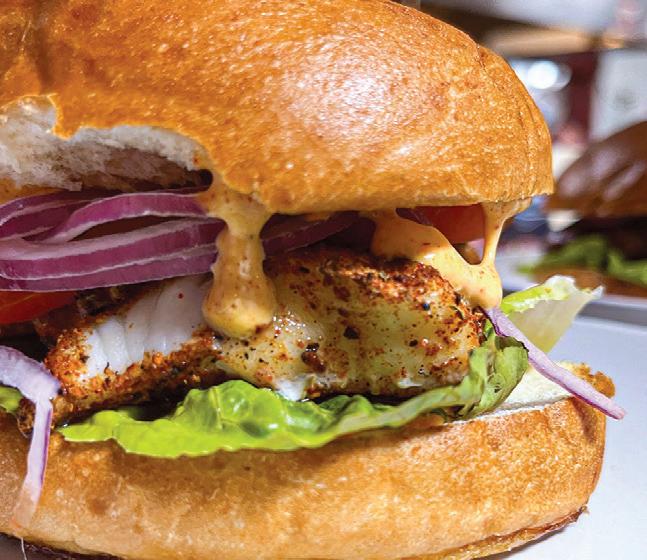
When Ken passed, Sam took over, and our partnership with him is a way to honor Ken’s legacy while supporting Sam’s young family. This deep-rooted connection to local fishermen not only enhances our menu, but also strengthens our bond with the Shelter Cove community.
TH In addition to working with local fishermen, are there any other local ingredients or partnerships that play a significant role in your brewing process?
JP We collaborate with local farms to bring the freshest ingredients to our kitchen. One of our key partners is Briceland Farms, run by Dan and Taylor, who practice regenerative farming. We source a variety of seasonal produce from them, from vibrant shishito peppers to heirloom tomatoes, ensuring that our dishes are as fresh and flavorful as possible. This partnership is a win for everyone involved – our cooks get to work with top-quality ingredients, our guests enjoy delicious farm-to-table meals and the farmers receive direct support from the community.
Another exciting collaboration is with Trinidad Bay Eatery, where we are working on a barrel-aged Oyster Stout. The oysters were added directly to the brew kettles, resulting in a
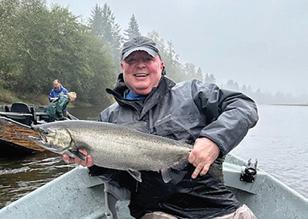
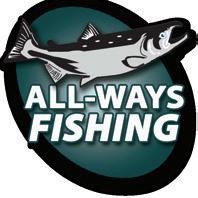
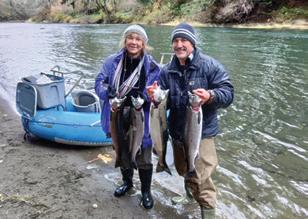


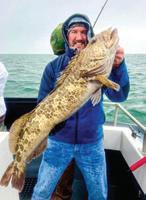











smooth, rich stout that is a true taste of the coast. These partnerships reflect our commitment to supporting local businesses and offering our guests an authentic taste of the Lost Coast.
TH Shelter Cove and the surrounding areas offer incredible fishing opportunities. Do you have any memorable fishing stories or other experiences related to your own outdoor adventures in California?
JP Fishing on the Lost Coast is an adventure that comes with its own set of challenges and rewards. One of my most memorable experiences was a trip with Tom, a local cannabis farmer and passionate fisherman. Knowing my tendency to get seasick, my husband advised me to take Dramamine – one pill the night before, one in the morning and one just before we set sail. I followed his advice to the letter, and while I didn’t get seasick, I also didn’t fully wake up for the rest of the day! Despite that, we had an incredible time, bringing home a bounty of salmon back when the season was still open. Tom, with his big gray beard and small boat, was always excited on the water, often flooding
Peacock hopes salmon fishing season will soon return to Northern California, where it’s such a big part of the culture. “Fishing on the Lost Coast is an adventure that comes with its own set of challenges and rewards,“ she says. (GYPPO ALE MILL)
our commitment to the local fishing community remains a cornerstone of our identity at Gyppo Ale Mill.
TH What are some of the most popular beers at Gyppo Ale Mill, and are there any seasonal brews that particularly celebrate the local environment?
the engine in his enthusiasm. My husband would have to remind him to relax, sometimes even encouraging him to smoke a joint to calm down. These trips are a reminder of the simple joys of life on the Lost Coast –good company, fresh fish and the kind of stories that stay with you forever.
TH How does Gyppo Ale Mill engage with the local fishing community? Can you share some insights into the local fishery there?
JP Our engagement with the local fishing community goes beyond just buying fish and crab. Over the years, we’ve been involved with the Shelter Cove Fishing Preservation group, working alongside figures like Jake Mitchell. Although the landscape has changed, particularly with the economic shifts brought about by the cannabis industry, we continue to support the local fishing community in any way we can. For instance, we supply 5-gallon buckets to the tractor drivers who help launch the boats, and we provide a welcoming space for fishermen to unwind after a long day on the water. While the nature of our engagement has evolved,
JP Our most popular beers are a reflection of our community’s tastes and the local environment. Dave’s Pilsner, our top seller, is a crisp, refreshing beer named after a community pillar. Our IPAs – Chasing Rainbows and Whistle Punk – are also fan favorites, offering bold flavors that resonate with the adventurous spirit of the Lost Coast. During the summer, we focus on lighter, more refreshing brews, while in the winter, we roll out richer, heartier options like our English mild ale, Bob’s Your Uncle. This beer, with its smooth, malty flavor, is a nod to the British saying that essentially means “there you have it,“ capturing the easy-going, no-fuss nature of our brewing philosophy. Each of these beers tells a story, whether it’s inspired by local legends, beloved community members, or the natural beauty that surrounds us.
TH Can you share a memorable story of how Gyppo Ale Mill has brought together people with a shared love of the outdoors and great beer?
JP Bringing people together is more than just our mission; it’s something that happens naturally every day. We see it in the hikers who finish the Lost Coast Trail and come in for a celebratory beer; in the locals who gather for our cornhole tournaments; and in the families who make us a part of their Shelter Cove traditions. One of our favorite traditions is our Lost Coast Legends Wall, where we take Polaroid photos of those who have conquered the Lost Coast Trail and proudly display them in our brewery. It’s a simple gesture, but it creates a sense of belonging and community that’s at the heart of what we do. Whether it’s through our friendly staff, our welcoming atmosphere, or




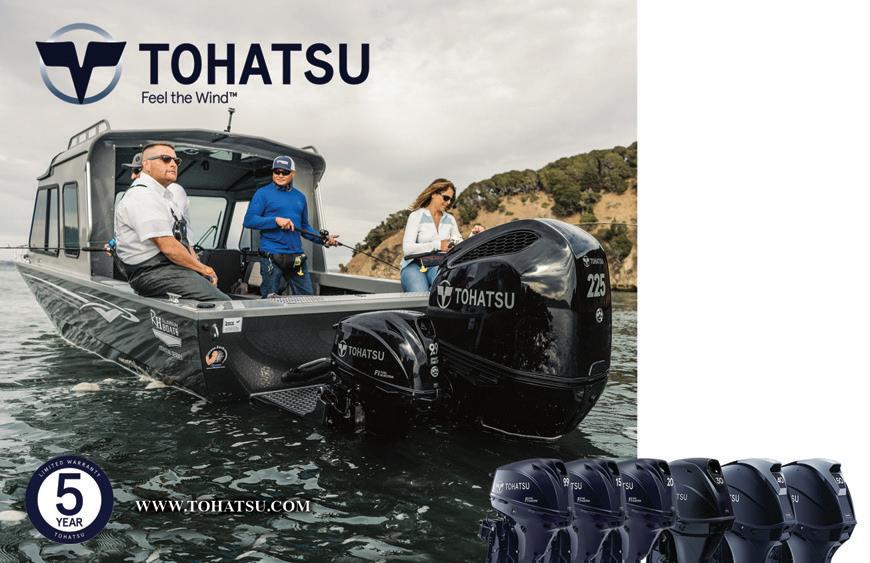
the shared love of the outdoors and good beer, Gyppo Ale Mill has become a place where connections are made, stories are shared, and memories are created every day.
TH Your brewery hosts various events throughout the year. Are there any upcoming events that celebrate the local outdoors culture that our readers should know about?
JP Our upcoming events are all about celebrating the vibrant outdoor culture of the Lost Coast. In September, we’ll be hosting our annual Oktoberfest, a week-long celebration from (October 1) to October 5. Each night will feature stein-holding contests, with the winners competing in the finals on Saturday. It’s a fun, festive event that brings the community together with bratwurst, Bavarian flags and plenty of beer.
In October, we’re excited to host the inaugural Paradise Royale Mountain
Bike Race, an event that showcases the rugged beauty of the Lost Coast. This race is not just about the competition; it’s about experiencing the breathtaking trails and the camaraderie that comes with pushing your limits in a stunning natural setting. These events are a testament to our commitment to celebrating the unique culture of the Lost Coast and bringing people together through shared experiences.
TH What advice would you give to someone visiting Shelter Cove for the first time, especially those interested in both enjoying your brews and exploring the local outdoor activities?
JP For those visiting Shelter Cove for the first time, I recommend embracing the incredible diversity of outdoor activities the area has to offer. Start your day with a hike on Black Sands Beach, where the dark sand and dramatic coastline provide a
striking backdrop for a morning walk. Visit the historic lighthouse, explore the labyrinth or take a leisurely stroll along the nature trail. If you’re more adventurous, try surfing the waves, mountain biking on the rugged trails or even golfing with an ocean view. After a day of exploring, there’s no better way to unwind than with a cold beer and a fresh meal at Gyppo Ale Mill. The Lost Coast is a nature lover’s paradise, offering endless opportunities for adventure and relaxation, all set against the backdrop of one of the most beautiful and unspoiled stretches of coastline in California. CS
Editor’s note: Like Gyppo Ale Mill at facebook.com/gyppoalemill and follow on Instagram (@gyppoalemill). The brewery also offers space for booking local events. See gyppo.com/bookings. Author Tiffany Herrington is a writer based in the Seattle, Washington, area.

